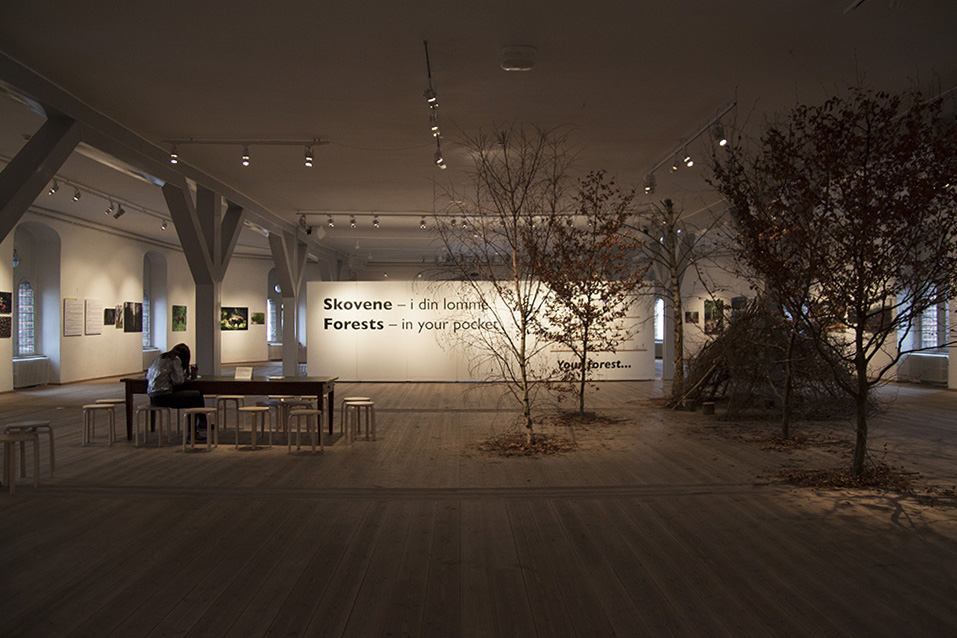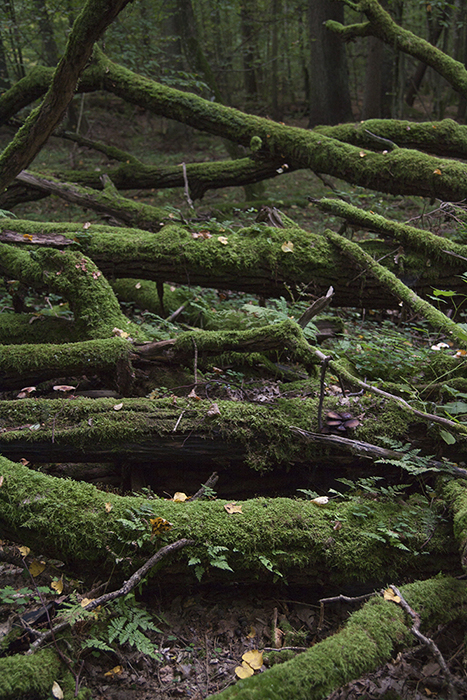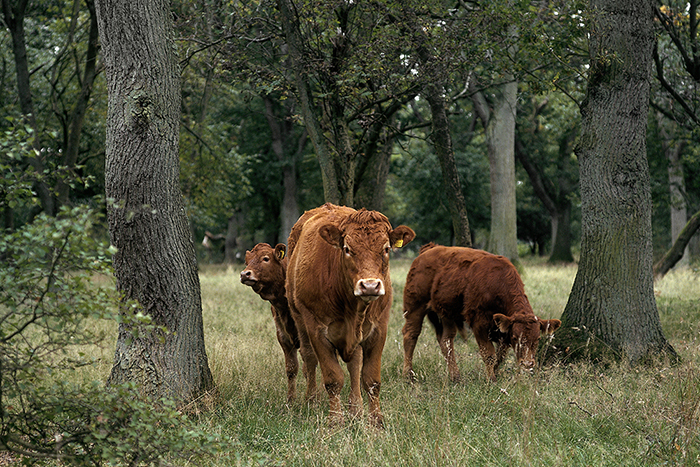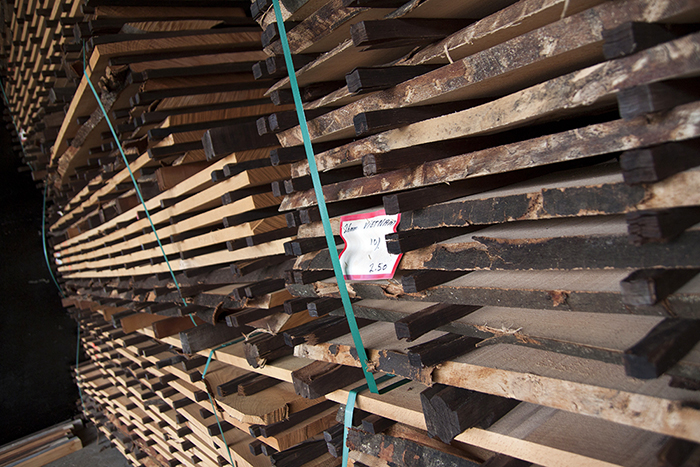The Forest festival is built around a photo exhibition illustrating forests in Denmark, Poland, Finland, Cambodia, Indonesia, and Malaysia. Unless otherwise noted biologist and main organizer of “Forests – in your pocket” Inger Kærgaard took the photographs. The exhibition is divided into four themes:
What is a forest?
We all have an idea of what a forest is. No explanation is needed when we hear someone say “Last Sunday I was with the family in the forest.” But defining a forest is surprisingly difficult. When does a collection of trees become a forest? Should the trees cover an area of a certain size, or are 5 trees enough to make up a forest? Can we plant a forest or does it then become plantations? And what about the number of tree species and the trees’ height, thickness and age? How about scents? Do certain scents indicate that we are in a forest? Or sounds? Can we determine whether something is a forest due to the sounds we hear? And must there be animals around before a scattered group of trees become a forest?
What do you think characterizes a forest?
FOREST DEFINITIONS
INTERNATIONAL
Worldwide, more than 800 different forest definitions are used. The international forest definition was developed by Food and Agriculture Organization of the United Nations (also called FAO), forms the basis of the national forest definitions and is also used for International forest statistic. FAO defines a forest as:
• Area of at least 0.5 hectares and 20 meters wide.
• Crown cover must be at least 10%, however, the area can be temporarily without trees.
• The trees should be able to reach a height of at least 5 meters.
• The main use should not be agriculture such as fruit tree plantations, but timber plantations such as rubber plantations are included as forest.
• Includes man-made as well as natural forest.
Changes in the criteria can be of great importance, statistically. For example, a change in the criteria about crown cover from 20 % to 10 % for industrialized countries in the year 2000, (all countries worldwide now have 10 %), meant that the forest cover grew – statistically – by about 400 millions hectares.
NATIONAL
Many national forest definitions are based on the FAO definition. This also applies to the Danish Forest Act. This means that planted stands of trees are considered as forest. If we excluded planted forests and only included natural forests, we would have very little forest in Denmark. In Malaysia, also oil palm plantations are included as forests in the national forest definition. Even though their purpose is agricultural. The consequence of this is that pristine rain forest with high biodiversity can be replaced with oil palm plantations without changing the country’s forest area.
The difficulty of defining forests is also evident in Indonesia. Forests are mentioned in about 500 laws on national and regional level. But none of the legislations includes a definition of what a forest is. Often, national laws prohibit local farmers from collecting firewoods and felling timber for their own use, even if the local traditional legal system has assigned the locals rights over the land.
PERSONAL
What the individual experiences as a forest is very individual, and depends on where in the world you live and what values you look at. Is it the economic value of the timber, the social and recreational values, as a walk in the countryside, the climate and carbon value, or the environment in the form of plant and animal species? Other factors, such as age, experiences in different forests and moods that day, also play a role.
If you ask sociologists, what a forest is, most probably the answer would be: “It is what you experience as a forest.”
Are forest defintions important? Justify your answer!
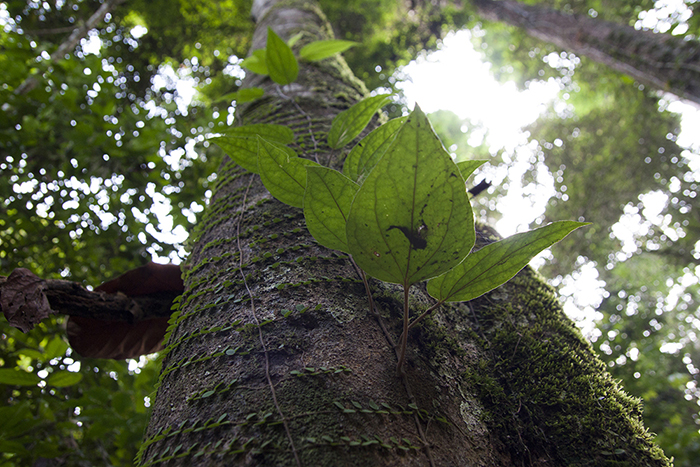 Photo 1: Tree with an epiphyte, Taman Negara, Malaysia, 2012. The tropical forests have many layers, and often the plants are growing on each other – usually in peaceful harmony.
Photo 1: Tree with an epiphyte, Taman Negara, Malaysia, 2012. The tropical forests have many layers, and often the plants are growing on each other – usually in peaceful harmony.
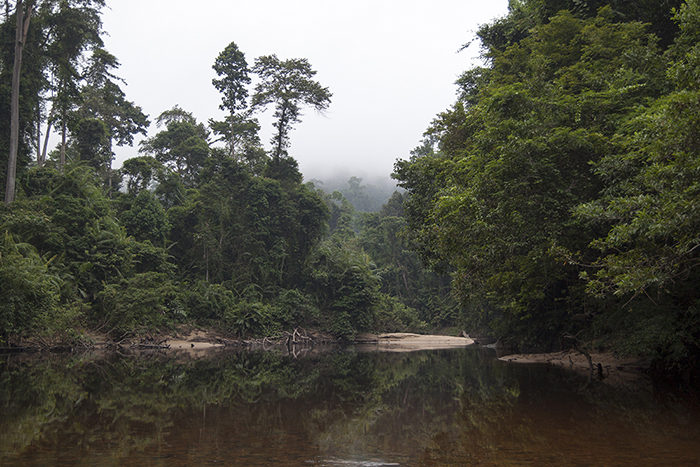 Photo 2: River and forest, Taman Negara, Malaysia, 2012. Taman Negara is believed to be 130 million years old and is probably the world’s oldest forest.
Photo 2: River and forest, Taman Negara, Malaysia, 2012. Taman Negara is believed to be 130 million years old and is probably the world’s oldest forest.
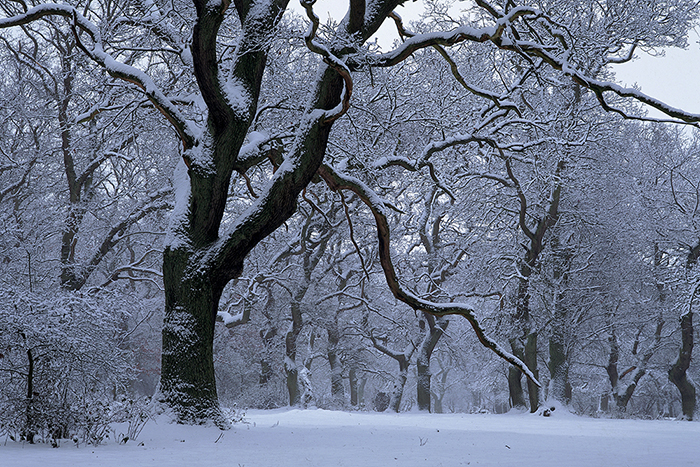 Photo 3: Winter in a unique Danish forest, Jutland, Denmark, 2012. Langå Egeskov is situated by the lakefront of the Gudenå. The area consists of three scenic areas: the 200 year old oak forest, a new oak forest and a meadow. The old oak forest with its thick, curved trunks is a unique example of ancient oak in Denmark. The Danish Fund for Nature bought the forest in 1992 from Løjstrup Main Farm, with the desire to preserve the old grazing forest as a living historical memory. The Danish Society for Nature Conservation photo and text. Photographer: Bert Wiklund / bwfoto.dk.
Photo 3: Winter in a unique Danish forest, Jutland, Denmark, 2012. Langå Egeskov is situated by the lakefront of the Gudenå. The area consists of three scenic areas: the 200 year old oak forest, a new oak forest and a meadow. The old oak forest with its thick, curved trunks is a unique example of ancient oak in Denmark. The Danish Fund for Nature bought the forest in 1992 from Løjstrup Main Farm, with the desire to preserve the old grazing forest as a living historical memory. The Danish Society for Nature Conservation photo and text. Photographer: Bert Wiklund / bwfoto.dk.
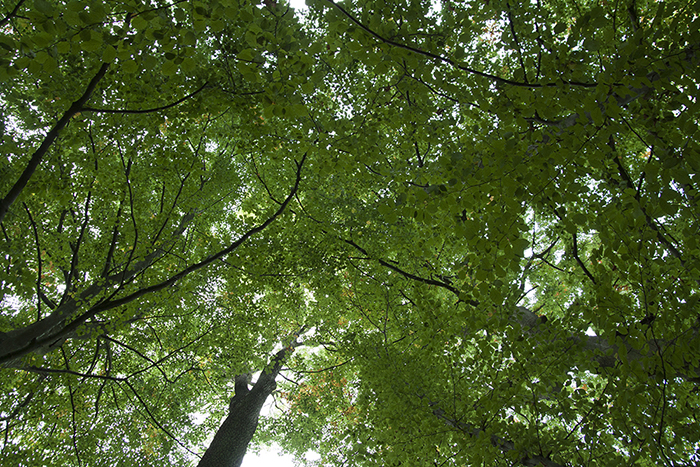 Photo 4: Oak trees – green, green, green. Boserup forest, Denmark. Who has not experienced lying on the forest floor, looking up into the trees and the green, and in a split second realized, how great it is to be in the forest?
Photo 4: Oak trees – green, green, green. Boserup forest, Denmark. Who has not experienced lying on the forest floor, looking up into the trees and the green, and in a split second realized, how great it is to be in the forest?
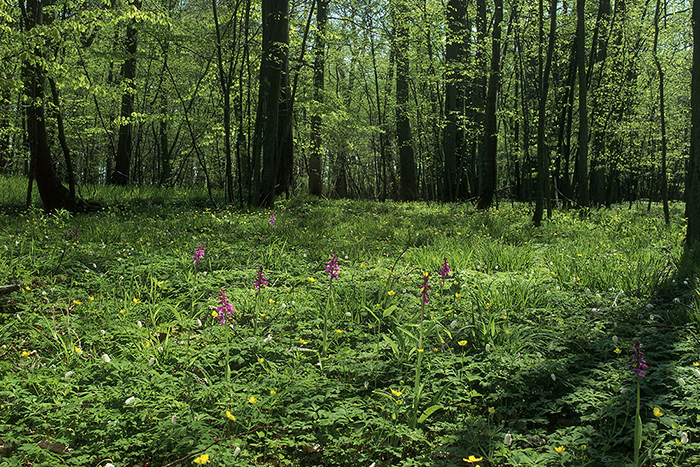 Photo 5: Spring on the forest floor with Heath Spotted-orchid Dactylorhiza maculata and Wood Anemone Anemone nemorosa, Langeland, Denmark. In spring there are plenty of flowers in Longelse “Farm forest” on Langeland.The forest has been protected and largely remained untouched since 1940. It became protected because the owner wanted to avoid being forced to cut down a lot of trees in the already old forest for firewood during the Second World War. A fertile soil helps to provide good conditions for the flowers on the forest floor. They use the light before the trees shade the forest floor completely. The forest is owned by the Danish Fund for Nature. The Danish Society for Nature Conservation photo and text. Photographer: Bert Wiklund / bwfoto.dk.
Photo 5: Spring on the forest floor with Heath Spotted-orchid Dactylorhiza maculata and Wood Anemone Anemone nemorosa, Langeland, Denmark. In spring there are plenty of flowers in Longelse “Farm forest” on Langeland.The forest has been protected and largely remained untouched since 1940. It became protected because the owner wanted to avoid being forced to cut down a lot of trees in the already old forest for firewood during the Second World War. A fertile soil helps to provide good conditions for the flowers on the forest floor. They use the light before the trees shade the forest floor completely. The forest is owned by the Danish Fund for Nature. The Danish Society for Nature Conservation photo and text. Photographer: Bert Wiklund / bwfoto.dk.
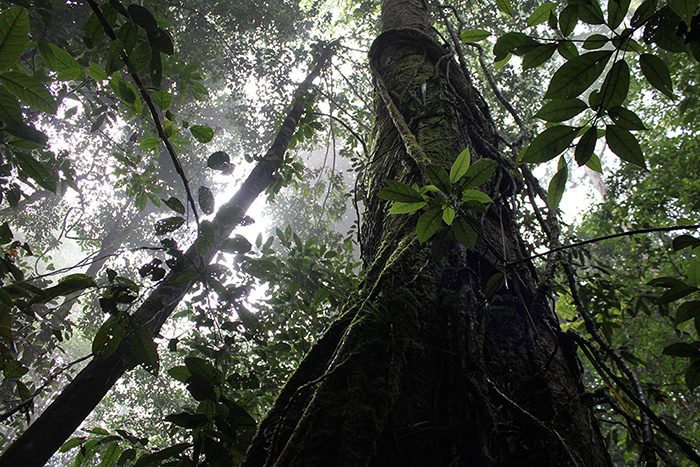 Photo 6: Wehea Forest, Borneo, Indonesia, 2009. Borneo has some of the world’s oldest rainforests. They are believed to be about 80 million years old. Unlike Java and elsewhere in Indonesia, Borneo almost has no active volcanoes. This, and the geographical location at the equator, has resulted in a very stable environment for millions of years. Have you ever been in a rainforest?
Photo 6: Wehea Forest, Borneo, Indonesia, 2009. Borneo has some of the world’s oldest rainforests. They are believed to be about 80 million years old. Unlike Java and elsewhere in Indonesia, Borneo almost has no active volcanoes. This, and the geographical location at the equator, has resulted in a very stable environment for millions of years. Have you ever been in a rainforest?
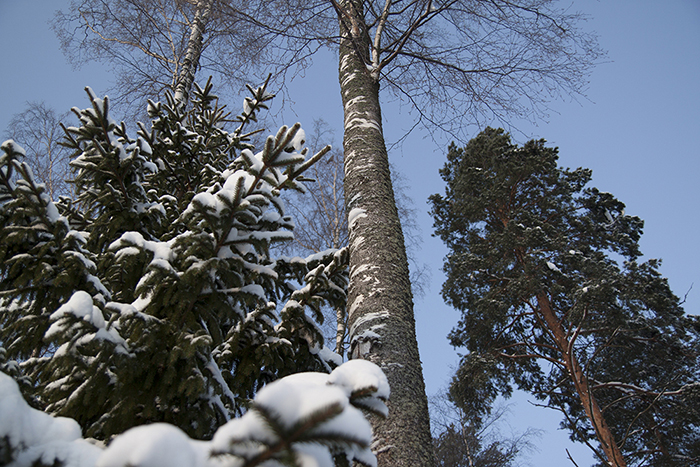 Photo 7: European Spruce Picea abies, Scots Pine Pinus sylvestris and silver birch Betula pendula, Espoo, Finland, 2012. Many of the forests in the northern hemisphere consist primarily of these 3 species. A relatively old forest does not necessarily need to have a very high biodiversity of tree species.
Photo 7: European Spruce Picea abies, Scots Pine Pinus sylvestris and silver birch Betula pendula, Espoo, Finland, 2012. Many of the forests in the northern hemisphere consist primarily of these 3 species. A relatively old forest does not necessarily need to have a very high biodiversity of tree species.
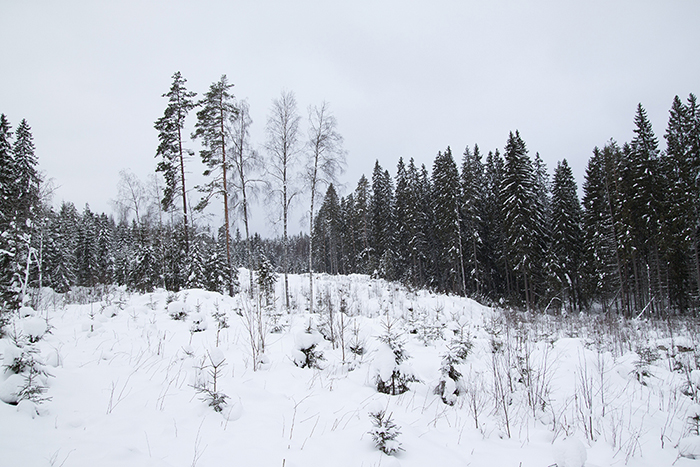 Photo 8: Production Forest, Tampere, Finland, 2012. There is a great diversity in the way the forests around the world are managed. The picture shows a forest patch which has just been logged. Finland has one of the world’s most intensive forest holdings and accounts for 25 % of the production of printing paper in the world. This is also evident in the forest. The natural rotation is around 350 years, and for paper production the trees grow until they are about 70 years. 95 % of all forests in Finland are PEFC certified, and one of the criteria to get this certification is that 5 trees per hectare should be left. This is done to protect biodiversity. How many trees do you think it takes, to make up a forest?
Photo 8: Production Forest, Tampere, Finland, 2012. There is a great diversity in the way the forests around the world are managed. The picture shows a forest patch which has just been logged. Finland has one of the world’s most intensive forest holdings and accounts for 25 % of the production of printing paper in the world. This is also evident in the forest. The natural rotation is around 350 years, and for paper production the trees grow until they are about 70 years. 95 % of all forests in Finland are PEFC certified, and one of the criteria to get this certification is that 5 trees per hectare should be left. This is done to protect biodiversity. How many trees do you think it takes, to make up a forest?
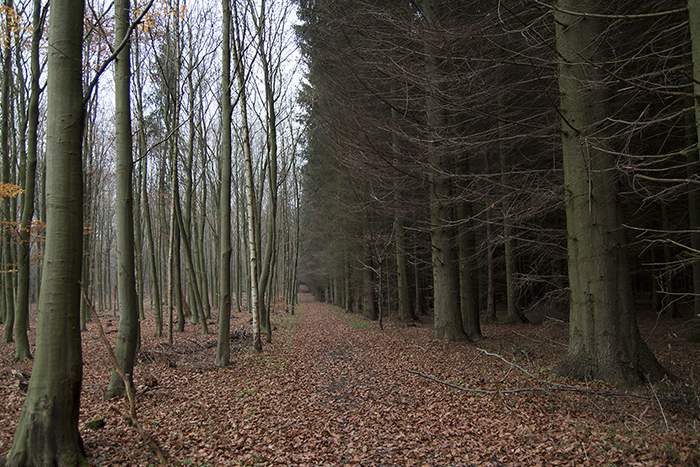 Photo 9: Beech forest Fagus sylvatica and spruce forest with a mixture of Grand Fir Abies grandis and European Spruce Picea abies, Bøllemosen, Danmark. The beech and spruce plantations in the picture were both planted in 1972. Fir trees grow much faster than beech trees. The Grand Fir is actually the fastest growing tree in Denmark. The species originates from North America and came to Denmark in the mid-1800s. The Grand Fir has only approximately half the weight as the beech trees.
Photo 9: Beech forest Fagus sylvatica and spruce forest with a mixture of Grand Fir Abies grandis and European Spruce Picea abies, Bøllemosen, Danmark. The beech and spruce plantations in the picture were both planted in 1972. Fir trees grow much faster than beech trees. The Grand Fir is actually the fastest growing tree in Denmark. The species originates from North America and came to Denmark in the mid-1800s. The Grand Fir has only approximately half the weight as the beech trees.
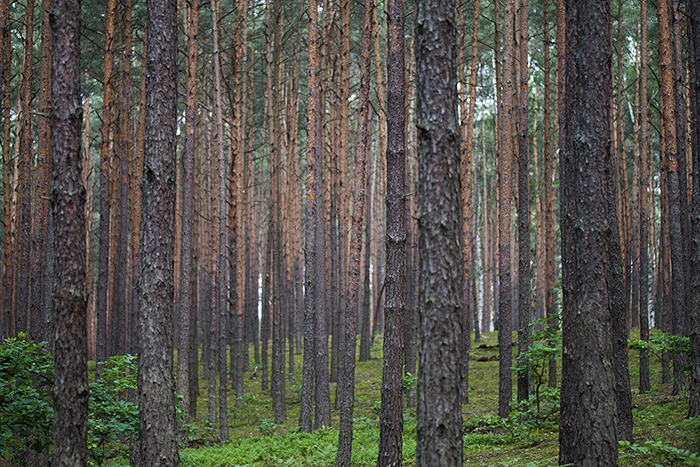 Photo 10: Scots Pine Pinus sylvestris with young oak Quercus robur trees beneath, Kampinoski National Park, Poland, 2012. The orange spots on some of the pines indicate that this plantation will soon be thinned. All trees with orange spot will be felled. The small oak trees on the forest ground suggest a desire to get away from the intensive forest monoculture. Do you think a forest can be planted?
Photo 10: Scots Pine Pinus sylvestris with young oak Quercus robur trees beneath, Kampinoski National Park, Poland, 2012. The orange spots on some of the pines indicate that this plantation will soon be thinned. All trees with orange spot will be felled. The small oak trees on the forest ground suggest a desire to get away from the intensive forest monoculture. Do you think a forest can be planted?
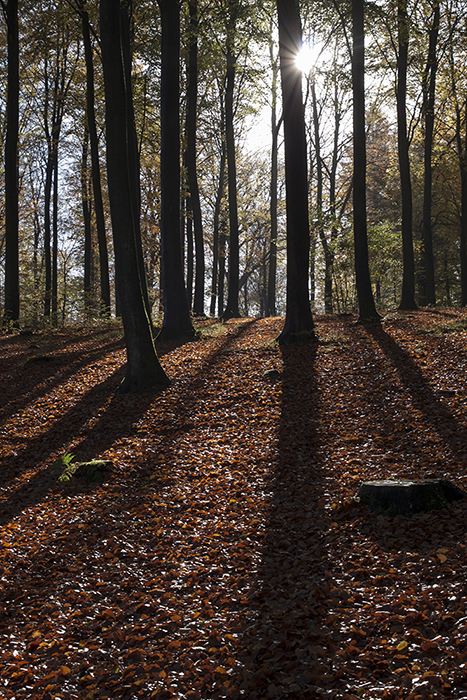 Photo 11: Beech forest, Fagus sylvatica, Jonstrup Vang, Denmark, 2012. This picture illustrates a typical Danish beech colonnade. Selective logging is taking place, as you can see from the tree stumps. Selective logging means that only certain trees in the forest are chosen for felling. This may be because they are intended for a particular purpose, or simply in order to provide light and space for other trees.
Photo 11: Beech forest, Fagus sylvatica, Jonstrup Vang, Denmark, 2012. This picture illustrates a typical Danish beech colonnade. Selective logging is taking place, as you can see from the tree stumps. Selective logging means that only certain trees in the forest are chosen for felling. This may be because they are intended for a particular purpose, or simply in order to provide light and space for other trees.
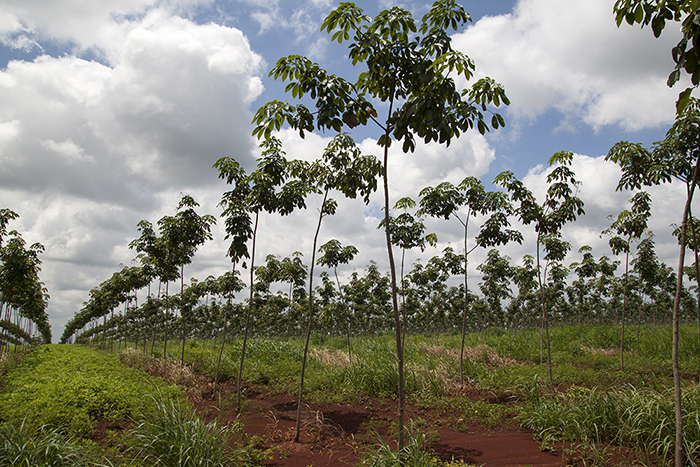 Photo 12: Young Rubber plantations with peanuts, Cambodia, 2012. Agro-forestry. Before rubber trees grow large, and their canopies block the sunlight, the soil can be used to grow other crops such as peanuts. Are trees planted in rows forests or plantations?
Photo 12: Young Rubber plantations with peanuts, Cambodia, 2012. Agro-forestry. Before rubber trees grow large, and their canopies block the sunlight, the soil can be used to grow other crops such as peanuts. Are trees planted in rows forests or plantations?
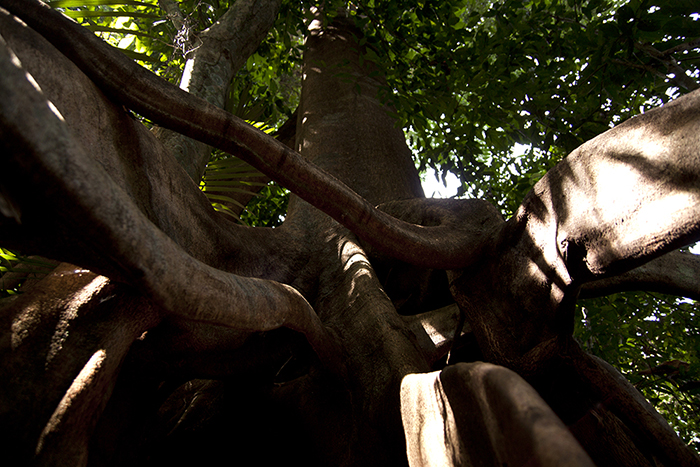 Photo 13: Tree with big treeroots, Taman Negara, Malaysia, 2012.
Photo 13: Tree with big treeroots, Taman Negara, Malaysia, 2012.
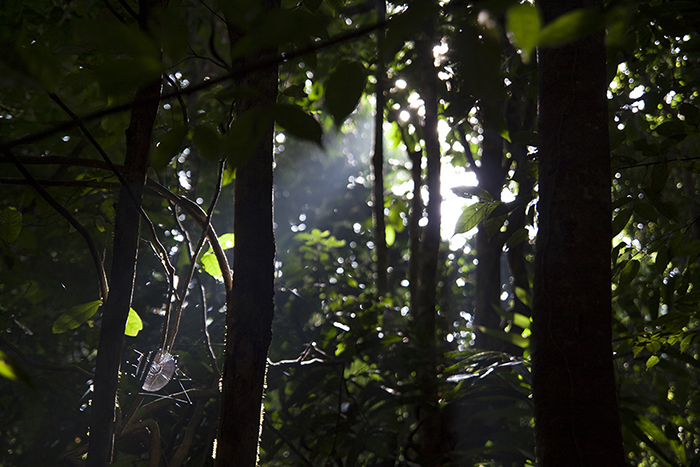 Photo 14: Only a little light makes it to the forest floor, Taman Negara, Malaysia, 2012.
Photo 14: Only a little light makes it to the forest floor, Taman Negara, Malaysia, 2012.
Photo 15: Dead wood, Bialowieza Forest, Poland, 2012. In this Polish primeval forest up to 2/3 of the biomass is placed in dead tree trunks and branches – i.e. dead wood. Dead trees are full of life. Woodpeckers, for example, find most of their food in dead trees. This is also where they primarily build their nests.
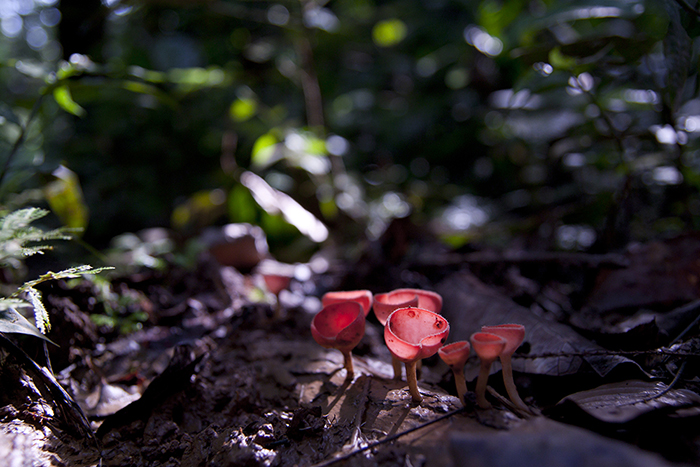 Photo 16: Cookeina speciosa on the forest ground, Taman Negara, Malaysia, 2012.
Photo 16: Cookeina speciosa on the forest ground, Taman Negara, Malaysia, 2012.
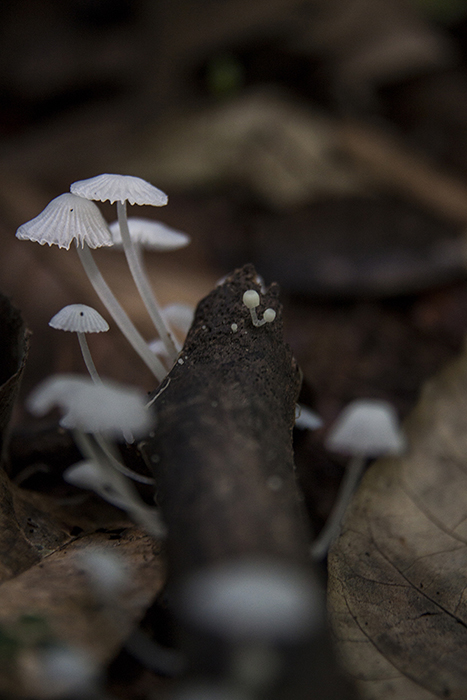 Photo 17: Bonnet sp. Taman Negara, Malaysia, 2012.
Photo 17: Bonnet sp. Taman Negara, Malaysia, 2012.
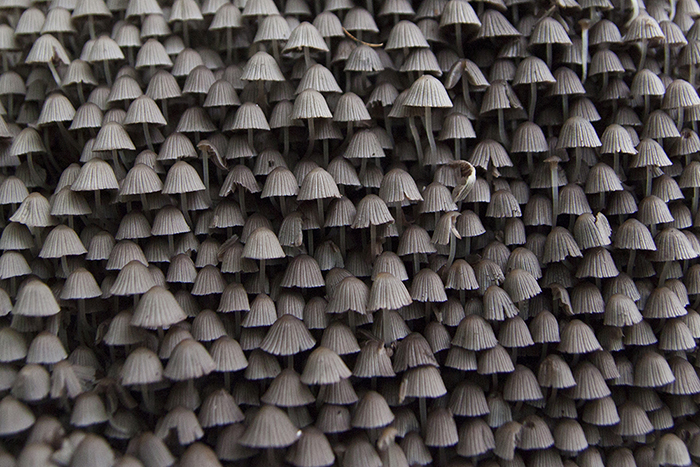 Photo 18: Fairy Bonnet, Coprinellus disseminatus, Boserup Forest, Denmark, 2012.
Photo 18: Fairy Bonnet, Coprinellus disseminatus, Boserup Forest, Denmark, 2012.
Why is the forest important?
Do you think it is important to preserve forests? Justify your answer!
The forests are important for many different reasons. Below you can read about some of the reasons.
LIFE IN THE FORESTS
The forests are full of life. 90 % of all terrestrial organisms live in the forests. Many, both well known and unknown animals, fungi and plants live in forests. Everyone knows tigers, orangutans and elephants, but what about the violin beetle and the spiny orb weaver? And what about all the species that are still hiding deep in the woods yet unknown to us humans? Scientists have reported about 1,700,000 animal species, but some estimates suggest that there are more than 8.7 million species. Many of these live in the forest.
TREES AND TREE SPECIES
A forest consists of more or less closely spaced trees. A tree is a large perennial with a lignified trunk. Some forests are full of different tree species – other forests consist of only a few species.
In tropical forests up to 450 tree species can be found per hectare, while forests in the north, such as Finland and Russia, often mainly consist of three different species. This is due to the different climate zones. Denmark is located in the temperate climate belt, which is characterized by cold winters. The tropical climate belt around the equator is hot and humid all year round, and has not changed much for millions of years. This has resulted in many species.
The oldest forest in the world is said to be 130 million years old. This is Taman Negara in Malaysia. Also Borneo’s rainforest is very old. In contrast, Denmark was covered with ice up to about 10,000 years ago, and our forests are not older than that. In fact, it is believed that man arrived in Denmark before the forest did.
How many tree species do you know?
THE FOREST FLOOR AND MUSHROOMS
A forest is much more than trees. On the forest floor, there are mushrooms. They help decompose organic matter. Mushrooms belong neither to the animal nor the plant kingdom; they are their own kingdom. Fungi live in symbiosis with trees. A symbiosis means a mutual dependence. The mushrooms provide nutrients to the trees, and in return, the trees give the mushrooms some of the sugar substance, which the trees have formed via photosynthesis. Thus both survive. Photosynthesis is the process by which the sun is used as an energy source to convert carbon dioxide and water into organic matter and oxygen.
The visible part of the fungus, which can be found in forests during the autunm, is called the fruitbody. But the fungi also have a lot of huge non-visible parts, which engulf the tree roots. They are called mycorrhizae (fungal hyphae). It is here that the exchange of nutrients takes place. The decomposing of organic material on the forest floor is also made by many other organisms, such as earthworms, insects and bacteria.
Do you collect mushrooms?
TIMBER
Trees have always had a great practical value to humans. They are used for firewood, building material and paper production. Timber is still the most environmentally friendly material for these purposes. But trees take a long time to grow, and it is important that we use the forest resources in a sustainable way, to ensure that there are trees in the future.
Would it be nice to live in a wooden house?
NON-TIMBER FOREST PRODUCTS
In addition to timber production, there are plenty of other resources in the forests. Mushrooms, berries, rattan, honey, meat from wild animals and medical plants are some examples of non-timber forest products.
In many countries, these products have a very high cultural as well as economic importance. For example, every year the Fins collect berries and mushrooms to an amount equivalent of some 520 million Danish kroner.
Can you think of some non-timber forest products from your everyday life?
HUNTING
Around the world, there are still many cultures that survive through hunting. In Denmark it is more a passionate hobby. Often the hunters also manage wildlife. They help regulate wild populations. The Bialowieza Forest in Poland would not be so well preserved today had it not been for royal and aristocratic hunting interests. These hunting interests were already being organized in the form of limited hunting licenses way back in the 1400s.
Do you go hunting? What are the qualities of going hunting?
RECREATIONAL VALUE
Often, a walk in the forest is like becoming 10 years younger in half an hour! The forest is our preferred recreational area. 80 % of all Danes visit the forest at least once a year.
It seems that trees increase our health and quality of life. Therefore, Frederiksberg (a municipality near Copenhagen) has decided that all its citizens should be able to see a tree from their window.
Many people use the forest for sunday walks, for a ride or for bird watching. The uses of the forest are almost endless.
When were you last in the forest?
CLIMATE
Forests are important both for the local climate, but also for the global climate. Locally, trees provide shade and that means lower temperatures. In the tropics, this means the surviving of living organisms. The global climate is also regulated by forests. Forests act as carbon sinks and store large amounts of carbon embedded in their tissues. When forests are burned, carbon is released to the atmosphere in the form of CO2. Deforestation and the subsequent fires in Indonesia mean that the country has one of the world’s largest emissions of CO2.
 Photo 19: The Forest is a good place to learn how to bike, Jonstrup Vang, Denmark, 2012. Only a few trees are allowed to grow really big in the Danish forests. These are called natural monuments. This large oak is called “The Tailor”and is approximately 365 years old.
Photo 19: The Forest is a good place to learn how to bike, Jonstrup Vang, Denmark, 2012. Only a few trees are allowed to grow really big in the Danish forests. These are called natural monuments. This large oak is called “The Tailor”and is approximately 365 years old.
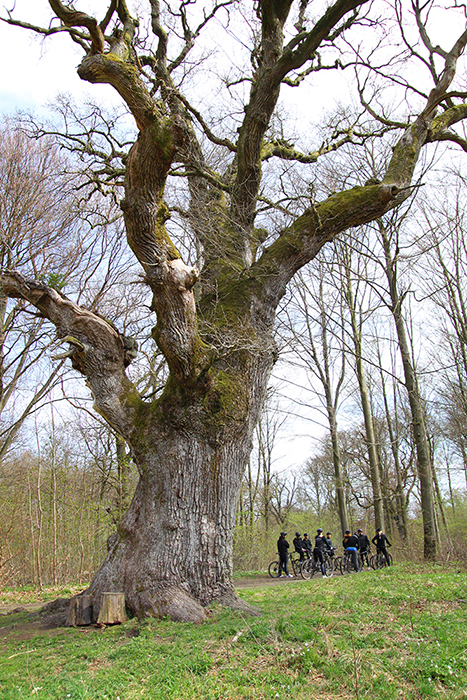 Photo 20: Mountain bikers under the oak tree “The Grenadier,” Jonstrup Vang, Denmark, 2012. Mountain bikers get instructions on how they should move around in the forests. The Danish state forests offer more than 350 km routes specific for mountain bikers. There are potential conflicts of interest associated with the use of the forest. Some would rather look at birds, and others prefer mountain biking. “The Grenadier” is approximately 700 years old.
Photo 20: Mountain bikers under the oak tree “The Grenadier,” Jonstrup Vang, Denmark, 2012. Mountain bikers get instructions on how they should move around in the forests. The Danish state forests offer more than 350 km routes specific for mountain bikers. There are potential conflicts of interest associated with the use of the forest. Some would rather look at birds, and others prefer mountain biking. “The Grenadier” is approximately 700 years old.
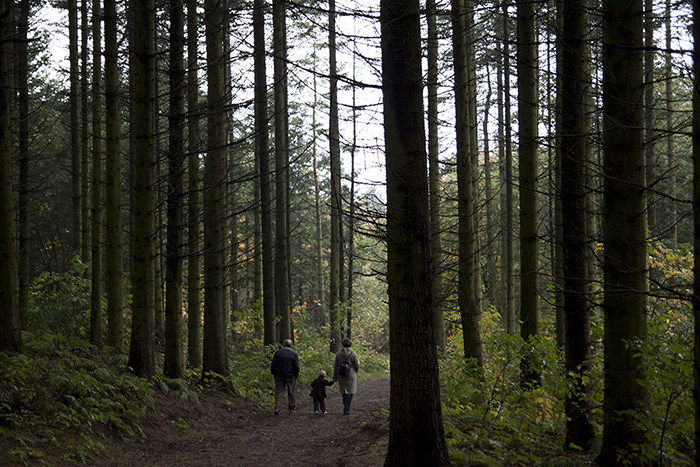 Photo 21: Walking in the forest, Bagterp Plantation, Denmark, 2012.
Photo 21: Walking in the forest, Bagterp Plantation, Denmark, 2012.
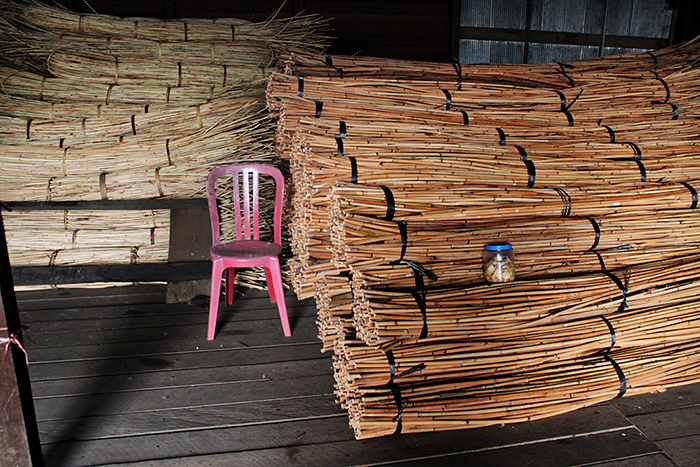 Photo 22: Rattan, Borneo, Indonesien, 2009. This rattan will be sailed from Borneo to Java, where it is made into furniture, which ends up in China, the U.S. and Europe. 70 % of the world’s rattanproduction is found in Indonesia. Rattan is a certain group of crawling palm trees that can grow several hundred meters long. There are over 600 different species.
Photo 22: Rattan, Borneo, Indonesien, 2009. This rattan will be sailed from Borneo to Java, where it is made into furniture, which ends up in China, the U.S. and Europe. 70 % of the world’s rattanproduction is found in Indonesia. Rattan is a certain group of crawling palm trees that can grow several hundred meters long. There are over 600 different species.
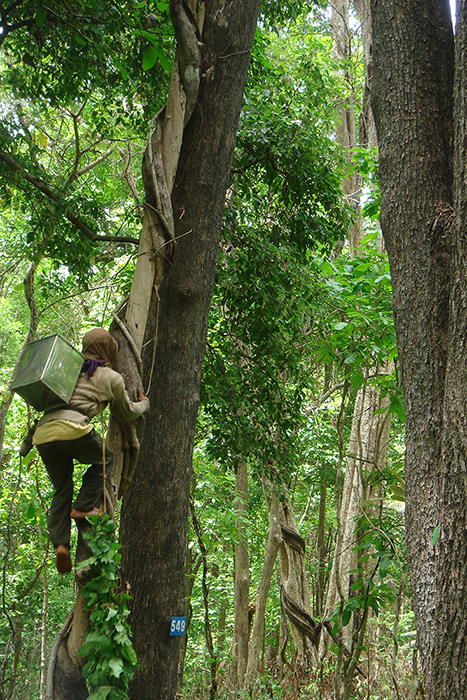 Photo 23: Honey collector, Cambodia. The EU has decided that Europen honey by definition comes from the European honey bee Apis mellifera. The indigenous people around the world have used honey from other species of bees for generations, however. In the old days, before the introduction of the use of sugarcane, Danish people also got their sugar from honey. Photographer: Femy Pinto, NTFP Cambodia.
Photo 23: Honey collector, Cambodia. The EU has decided that Europen honey by definition comes from the European honey bee Apis mellifera. The indigenous people around the world have used honey from other species of bees for generations, however. In the old days, before the introduction of the use of sugarcane, Danish people also got their sugar from honey. Photographer: Femy Pinto, NTFP Cambodia.
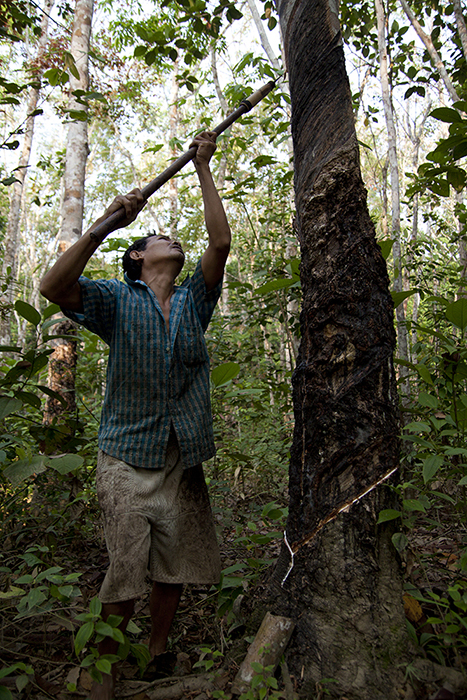 Photo 24: Rubber tapper, Harapan Forest, Sumatra, Indonesia, 2012. This rubber tapper was born in Harapan Forest. Since he was a child he has worked in the family’s rubber plantation. The plantation covers an area of almost one quarter km2 and was planted by his grandparents in 1960 to ensure their children and grandchildren an income. This is his life insurance. The plantation is a “forest garden”. This means that the rubber trees grow amongst other trees, in contrast to the intensive plantations of monoculture where only one plant is grown. This interferes less with the development of natural vegetation. The trees are therefore less vulnerable to pests and do not require fertilizers or pesticides. Since rubber trees do not require high investments or expensive machines, they have for generations been an important source of income for small scale farmers in the tropics.
Photo 24: Rubber tapper, Harapan Forest, Sumatra, Indonesia, 2012. This rubber tapper was born in Harapan Forest. Since he was a child he has worked in the family’s rubber plantation. The plantation covers an area of almost one quarter km2 and was planted by his grandparents in 1960 to ensure their children and grandchildren an income. This is his life insurance. The plantation is a “forest garden”. This means that the rubber trees grow amongst other trees, in contrast to the intensive plantations of monoculture where only one plant is grown. This interferes less with the development of natural vegetation. The trees are therefore less vulnerable to pests and do not require fertilizers or pesticides. Since rubber trees do not require high investments or expensive machines, they have for generations been an important source of income for small scale farmers in the tropics.
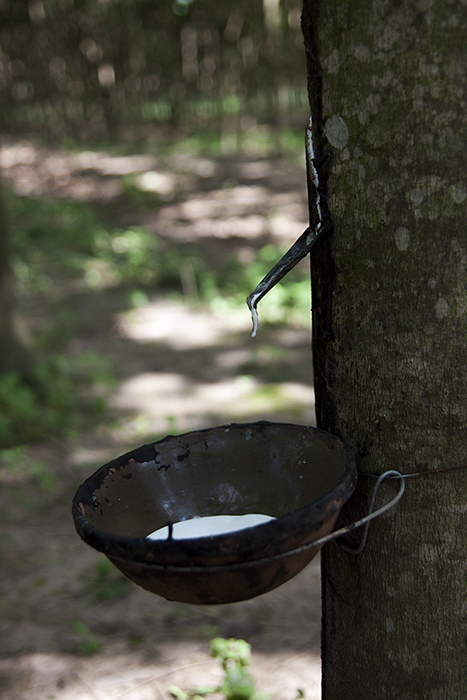 Photo 25: Rubber tapping, Cambodia, 2012. Originally, the rubber tree Hevea brasiliensis is native to the Amazon, but is now widespread throughout the tropics. The tree produces natural rubber, which is a white milky juice (latex). This is tapped by making an incision in the bark and placing a bowl underneath for the latex to run into. In spite of the increase of synthetic rubber, natural rubber is still being used in many rubber products such as rubber boots. The natural rubber trees can be tapped when they reach the age of 5-9 years and they live 70-100 years. In many places, however, a cloned rubber tree species has been planted which grows faster and provides more latex. The seeds from this species are more expensive, and the trees have a much shorter life span and are less resistant to disease.
Photo 25: Rubber tapping, Cambodia, 2012. Originally, the rubber tree Hevea brasiliensis is native to the Amazon, but is now widespread throughout the tropics. The tree produces natural rubber, which is a white milky juice (latex). This is tapped by making an incision in the bark and placing a bowl underneath for the latex to run into. In spite of the increase of synthetic rubber, natural rubber is still being used in many rubber products such as rubber boots. The natural rubber trees can be tapped when they reach the age of 5-9 years and they live 70-100 years. In many places, however, a cloned rubber tree species has been planted which grows faster and provides more latex. The seeds from this species are more expensive, and the trees have a much shorter life span and are less resistant to disease.
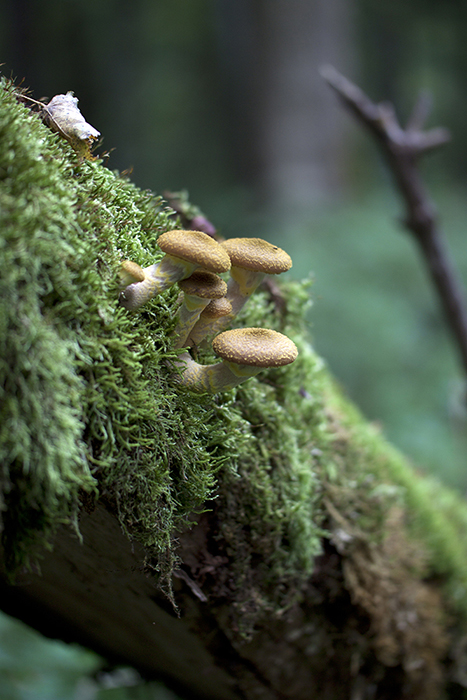 Photo 26: Bulbous Honey Fungus Armillaria lutea, Bialowieza Forest, Polen, 2012.
Photo 26: Bulbous Honey Fungus Armillaria lutea, Bialowieza Forest, Polen, 2012.
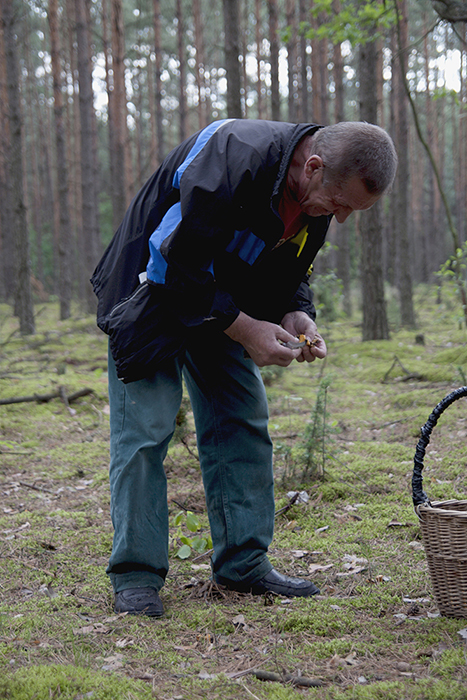 Photo 27: Mushroom picking, Kampinoski National park, Poland, 2012. Mushrooms are an important forest product. The picture shows the picking of the common Chanterelle Cantharellus cibarius. An estimated 1.5 million fungi species exist in the world, hundreds of them are edible. Collection of wild mushrooms from the forests is a widespread tradition in Slavic countries, such as Poland, and creates an additional source of income for the rural population. They are also an important part of the food culture – the taste of Poland is the taste of mushrooms and other forest products.
Photo 27: Mushroom picking, Kampinoski National park, Poland, 2012. Mushrooms are an important forest product. The picture shows the picking of the common Chanterelle Cantharellus cibarius. An estimated 1.5 million fungi species exist in the world, hundreds of them are edible. Collection of wild mushrooms from the forests is a widespread tradition in Slavic countries, such as Poland, and creates an additional source of income for the rural population. They are also an important part of the food culture – the taste of Poland is the taste of mushrooms and other forest products.
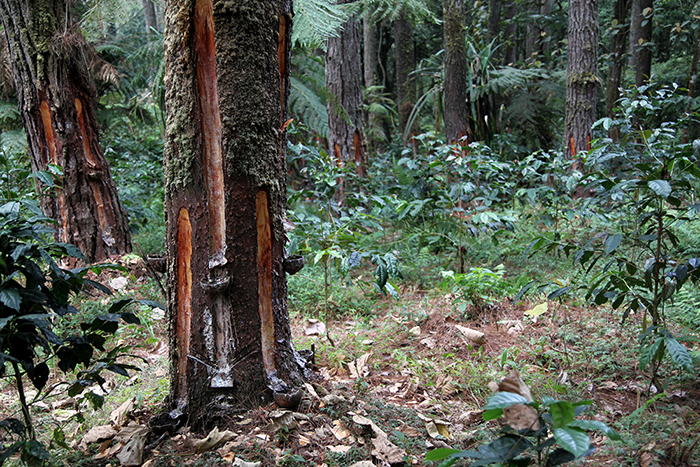 Photo 28: Resin tapping and coffee plants, Java, Indonesia 2012. Harvesting of resin is common in Southeast Asian countries such as Indonesia. Here the resin is tapped from the pine tree Pinus merkusii by cutting a hole in the trunk. Fire is often used to increase the leakage of resin. Resin is a source of income for many poor people. It is used traditionally as medicine for skin diseases, to prevent iron tools from rust, and to manufacture torches, incense, shoe polish, cement and cosmetics. How does resin actually smell?
Photo 28: Resin tapping and coffee plants, Java, Indonesia 2012. Harvesting of resin is common in Southeast Asian countries such as Indonesia. Here the resin is tapped from the pine tree Pinus merkusii by cutting a hole in the trunk. Fire is often used to increase the leakage of resin. Resin is a source of income for many poor people. It is used traditionally as medicine for skin diseases, to prevent iron tools from rust, and to manufacture torches, incense, shoe polish, cement and cosmetics. How does resin actually smell?
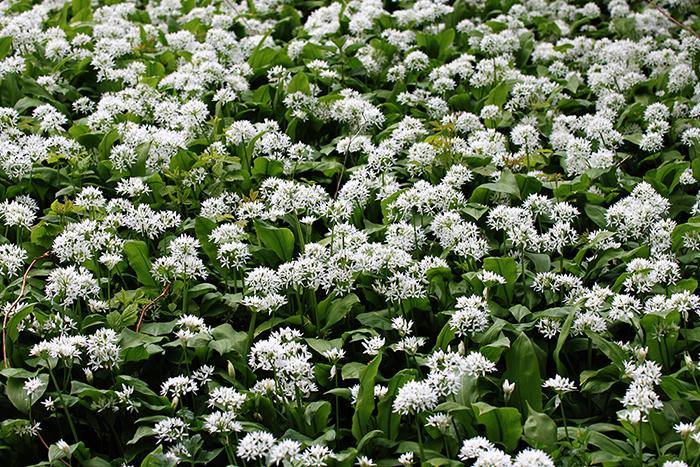 Photo 29: Ramsons Allium ursinum, Gudhjem, Denmark, 2012. In spring, when you walk in the woods, sometimes you are suddenly come across the smell of strong garlic – it is ramsons, also called wild garlic. You can make pesto of it. They should be harvested before they begin to flower.
Photo 29: Ramsons Allium ursinum, Gudhjem, Denmark, 2012. In spring, when you walk in the woods, sometimes you are suddenly come across the smell of strong garlic – it is ramsons, also called wild garlic. You can make pesto of it. They should be harvested before they begin to flower.
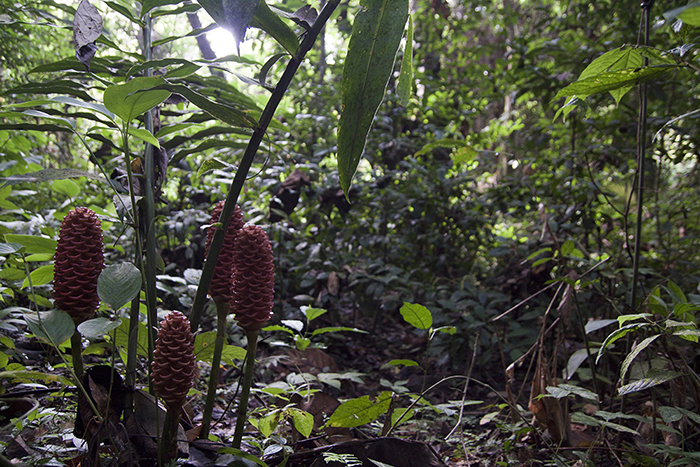 Photo 30: Ginger Zingiber spectabilis, Taman Negara, Malaysia, 2012. There are about 2000 different species of ginger. This species is distributed from southern Thailand to the Malaysian Peninsula. It has a flower of each supporting leave. The supporting leaves are popular ornamental plants in tropical gardens. This ginger forms a liquid that can be used as a shampoo. The shampoo is stored in a small container made by the supporting leaves. The plant is believed to use this liquid as a part of its immune system.
Photo 30: Ginger Zingiber spectabilis, Taman Negara, Malaysia, 2012. There are about 2000 different species of ginger. This species is distributed from southern Thailand to the Malaysian Peninsula. It has a flower of each supporting leave. The supporting leaves are popular ornamental plants in tropical gardens. This ginger forms a liquid that can be used as a shampoo. The shampoo is stored in a small container made by the supporting leaves. The plant is believed to use this liquid as a part of its immune system.
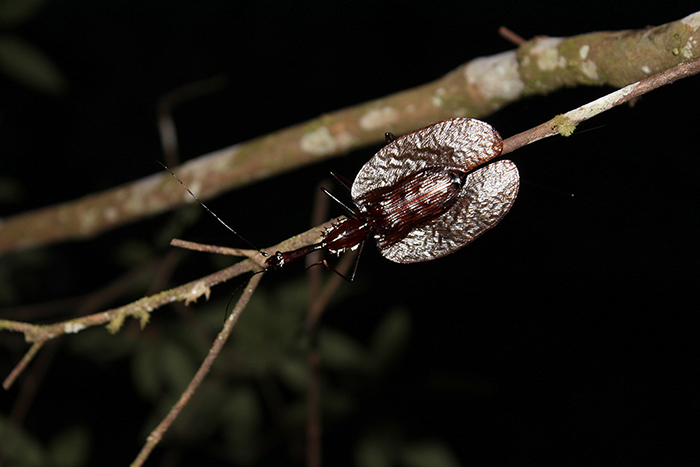 Photo 31: Violin beetle Mormolyce borneensis, Borneo, Indonesien, 2009. This violin beetle is related to the Danish ground beetles. Around the tropics there is the greatest diversity of plant- and animal species, including insects. Insects thrive in the tropics; this is because they are ectothermic animals, which need heat to move around. When was the last time you looked closely at an insect?
Photo 31: Violin beetle Mormolyce borneensis, Borneo, Indonesien, 2009. This violin beetle is related to the Danish ground beetles. Around the tropics there is the greatest diversity of plant- and animal species, including insects. Insects thrive in the tropics; this is because they are ectothermic animals, which need heat to move around. When was the last time you looked closely at an insect?
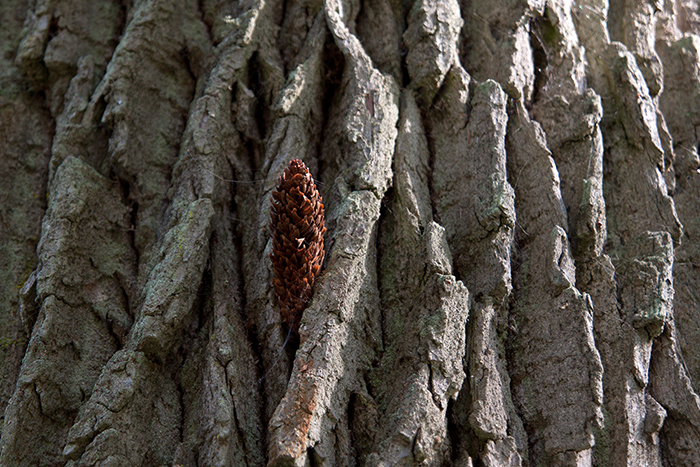 Photo 32: Pine cone wedged into the bark of oak, Bialowieza Forest, Poland, 2012. Different species of woodpeckers wedge pine cones into the grooves on the bark of oak. When the cone is stuck, the woodpecker can eat the seeds. How smart do you think birds are?
Photo 32: Pine cone wedged into the bark of oak, Bialowieza Forest, Poland, 2012. Different species of woodpeckers wedge pine cones into the grooves on the bark of oak. When the cone is stuck, the woodpecker can eat the seeds. How smart do you think birds are?
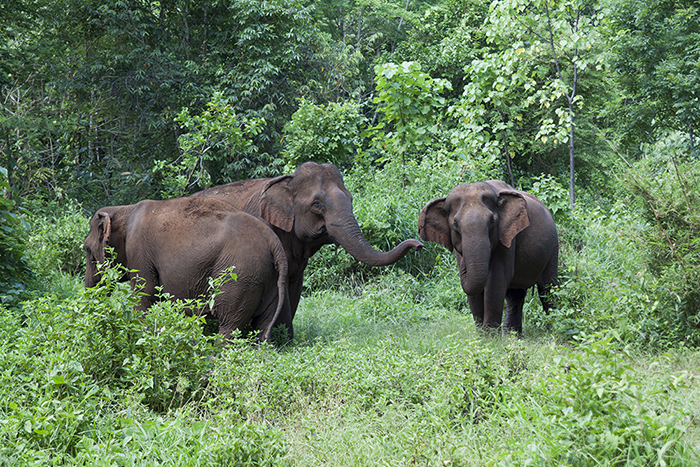 Photo 33: Elephants Elephas maximus, Mondulkiri, Cambodia, 2012. The Asian elephants are found almost all over Asia. They are used for the transportation of timber out of the forests. To make the elephants cooperative and tame, they are traumatized by violence from newborns. This makes it difficult to release them into the wild again, as they have lost their natural fear of people. The Asian elephant is on the IUCN Red List of endangered species. Unfortunately the ivory trade is still flourishing in many countries, despite an international ban. These elephants are from the Elephant Valley Project. Have you ever done elephant trekking?
Photo 33: Elephants Elephas maximus, Mondulkiri, Cambodia, 2012. The Asian elephants are found almost all over Asia. They are used for the transportation of timber out of the forests. To make the elephants cooperative and tame, they are traumatized by violence from newborns. This makes it difficult to release them into the wild again, as they have lost their natural fear of people. The Asian elephant is on the IUCN Red List of endangered species. Unfortunately the ivory trade is still flourishing in many countries, despite an international ban. These elephants are from the Elephant Valley Project. Have you ever done elephant trekking?
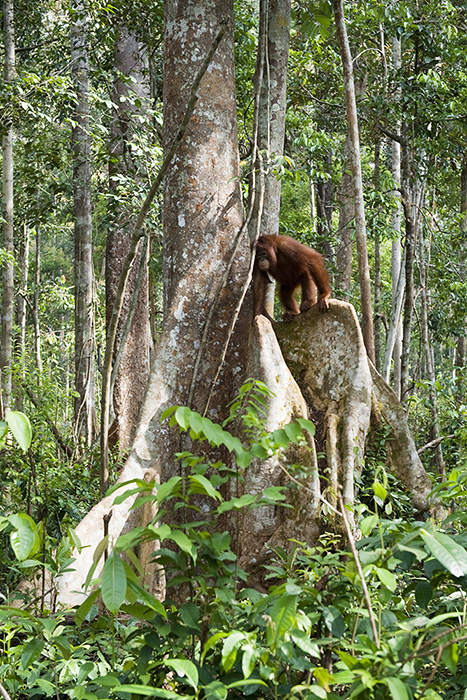 Photo 34: Orangutan – man of the forest, Borneo, Indonesia. Orangutan means “man of the forest “. This is not without reason. 97 percent of the orangutan’s DNA is identical to humans’, and the red-haired ape is in many ways similar to humans, both in appearance and behavior. Orangutans live in lowland forests on the islands of Borneo and Sumatra in Southeast Asia. They live in trees and will only reluctantly approach the forest floor. Many of the orangutan’s original habitats have disappeared due to intensive logging, and it is therefore threatened with extinction. Text and photo Save the Orangutan, photographer: Christian Aars Lund.
Photo 34: Orangutan – man of the forest, Borneo, Indonesia. Orangutan means “man of the forest “. This is not without reason. 97 percent of the orangutan’s DNA is identical to humans’, and the red-haired ape is in many ways similar to humans, both in appearance and behavior. Orangutans live in lowland forests on the islands of Borneo and Sumatra in Southeast Asia. They live in trees and will only reluctantly approach the forest floor. Many of the orangutan’s original habitats have disappeared due to intensive logging, and it is therefore threatened with extinction. Text and photo Save the Orangutan, photographer: Christian Aars Lund.
Photo 35 (Photo is missing): Bisons in the Bialowieza Forest, Poland. The European bison Bison bonasus is Europe’s largest land mammal and an endangered species. At the beginning of the 1900s, it was almost extincted due to deforestation and hunting. The last wild bison was shot in the Polish Bialowieza Forest in 1919. A breeding program was subsequently launched, and today there are nearly 500 bison in Bialowieza Forest. Unlike its American cousin, the European Bison lives in the forest. In May 2012, seven bison from Poland were released in Almindingen on the Danish island of Bornholm. The species disappeared from Denmark a few thousand years ago. This image is from the book: SAGA OF THE ANCIENT FOREST by Jan Walencik (first edition – English / Polish – will be released in the second half of 2013).
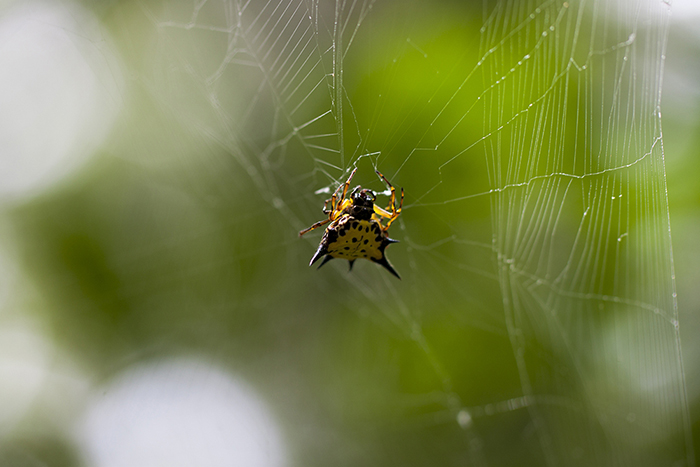 Photo 36: Hasselt`s Spiny Spider Gasteracantha hasselltii, Mondulkiri, Cambodia, 2012. This spider belongs to the family of orb-weaver spiders (Araneidae). This species is widespread throughout Asia from India to Indonesia. Also our resident cross spider belongs to this family. There are hundreds of different very beautiful spiders in the tropics. Many are not yet known to science. Would you like to research spiders?
Photo 36: Hasselt`s Spiny Spider Gasteracantha hasselltii, Mondulkiri, Cambodia, 2012. This spider belongs to the family of orb-weaver spiders (Araneidae). This species is widespread throughout Asia from India to Indonesia. Also our resident cross spider belongs to this family. There are hundreds of different very beautiful spiders in the tropics. Many are not yet known to science. Would you like to research spiders?
Photo 37: Cows in the forest, Jutland, Denmark. Grazing cows in Langå Egeskov by the lakefront of the Gudenå. Here we have the unique forest picture of crooked oak forest bitten by cattle, as we know from the Golden Age paintings. The Danish Fund for Nature owns the forest. It is important both to preserve the old oak trees and to alllow new oak to grow up so they can become tomorrow’s “golden age-trees”. Once, cows and pigs were a very common sight in the Danish forest. However, in 1805 they became banned from the forest. This was because the animals ate so many acorns and beech nuts and trampled the little trees that no new trees grew up. In this forest, the owners made an exception and the cows were allowed to stay. This was fortunate for the old oak trees, which continued to get light and air. The Danish Society for Nature Conservation photo and text. Photographer: Bert Wiklund / bwfoto.dk.
Why is the forest disappearing?
Why do the forests disappear? And to what extend do they do so? The assessment of whether or not the forests are disappearing depends on where in the world you are and how you define the word “forest”. If you measure only by forest cover (areas covered with trees), forests are increasing in the industrialized world, while they continue to disappear in tropical countries. There are many reasons for this.
Why do you think that the forest is disappearing?
AGRICULTURAL DEVELOPMENT
An increasing population and a higher living standard increase the pressure on the world’s natural resources including land resources. One of the main drivers of deforestation is the fact that forests are cleared to make way for food production – e.g. soybean and cattle (in South America), and palm oil (in Asia). About half of the protein content in Danish pig feed comes from soybeans from South America.
TRANSMIGRATION PROGRAMME
The need for agricultutal land has also resulted in the relocation of populations in several places around the world. The people in overpopulated areas are being offered a piece of land in forested regions. Forest is considered a potential piece of land for farming. On Borneo, for instance, land was, for a long time, considered an inexhaustible resource. Therefore, large groups of people from Bali and from Java live on the island of Borneo. They have been promised 2 hectares of agricultural land (forest).
OIL PALM
Oil palm Elaeis guineensis originates from Africa. The first time the plant came to Asia was as an ornamental plant in 1875. Since then, giant oil palm plantations have been planted, replacing tropical forest, and today oil palm plantations constitute one of the primary causes of deforestation in Southeast Asia. Malaysia and Indonesia are the world’s leading producers of palm oil, and together the two countries dominate the global market with 86 % of the production (2008 figures).
Palm oil is one of the most commonly used vegetable oils worldwide – it is found in e.g. shampoo, candles, soap, cosmetics, cookies, ice cream, and meat. Palm oil is hidden under the name of “vegetable oil,” and it is therefore impossible to know whether the product contains sunflower, rape or palm oil. Palm oil may also be used as biofuel mixed with petrol and diesel.
The world’s consumption of palm oil has doubled since 2002 and global demand is increasing. The expansion of oil palm plantations thus continue.
Have you eaten palm oil today?
RUBBER
Rubber tree Hevea brasiliensis is one of the trees that have changed the world. Maybe you can go so far as to say: “Without rubber, bicycles and cars would never have been as popular as they are today.” Rubber tree is indigenous to the Amazon, but is now widespread throughout the tropics.
Do you have rubber on you now? Do you know where it comes from?
BIOFUELS
Forests can also be logged in the name of biofuel – e.g. in the case of palm oil production for fuel use. There are three main types of biofuel: 1. Waste (wood chips, paper and waste, agricultural waste), 2. Crops grown for biofuel (arrow, energy grain and miscanthus), 3. Crops can also be applied to food (palm oil, canola, corn, and sugar beet). In the EU, there is a growing interest in biofuels, because biofuels are believed to be CO2 neutral.
It is important to distinguish between the different types of biomass. At worst, primary forest is felled to produce biofuel, but is it then still a climate-friendly energy source?
How do you heat-up your home?
ILLEGAL LOGGING
In many countries, it is not well defined, who owns the land and the question “Who owns that tree over there?” is often a very relevant question to ask, even if somewhat difficult to answer.
In a country like Denmark, it is easy to define what is illegal. In a country like Indonesia it can be very difficult. Back in the 1990s, Indonesia’s former president, Suharto, declared many of Indonesia’s forests to be state forests, which meant that he could rent them out to logging companies. He had overlooked the fact that many of these forests actually belonged to someone – someone who used the forest both for timber production and for the production of non-timber related products. In this way, the locals were made into criminals, even if all they did was what they had done for generations.
Have you ever lost a tree? Or have you ever helped to cut down a tree?
ILLEGAL TRADE IN TIMBER CLEARING FORESTS FOR TREES
There are various reasons behind the illegal logging. There are local, but there are also international causes – such as timber consumption in Europe. If there is a market for it, then there is always someone who will try to make money. There are huge sums of money at stake, and illegal deforestation constitutes one of the greatest threats to forests in the tropics. Up to 50-90 percent of the deforestation in Southeast Asia, the Amazon and Central Africa is believed to be caused by illegal logging. The countries lose enormous revenues, people are robbed of important natural resources and local people are kept in poverty. In addition, illegal logging brings with it assaults, threats and killings of people who work for forest conservation – every year lives lost as a result.
Where does your furniture come from?
MINING
The discovery of raw materials, such as coal or gold, often has disastrous consequences for the forest.
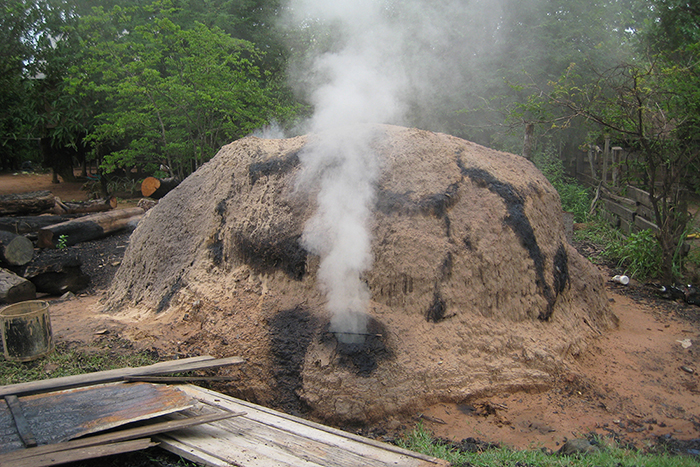 Photo 38: Traditional charcoal production, Cambodia. Charcoal is basically charred pieces of wood. Traditionally it is produced in ovens, consisting of hemispherical piles of wood covered with soil. 100 kg wood material can produce about 25 kg charcoal. Worldwide, about 40 % of the population depends on wood fuel, mainly wood and charcoal for cooking and heating. This results in large deforestation. Photographer: Maya Pasgaard.
Photo 38: Traditional charcoal production, Cambodia. Charcoal is basically charred pieces of wood. Traditionally it is produced in ovens, consisting of hemispherical piles of wood covered with soil. 100 kg wood material can produce about 25 kg charcoal. Worldwide, about 40 % of the population depends on wood fuel, mainly wood and charcoal for cooking and heating. This results in large deforestation. Photographer: Maya Pasgaard.
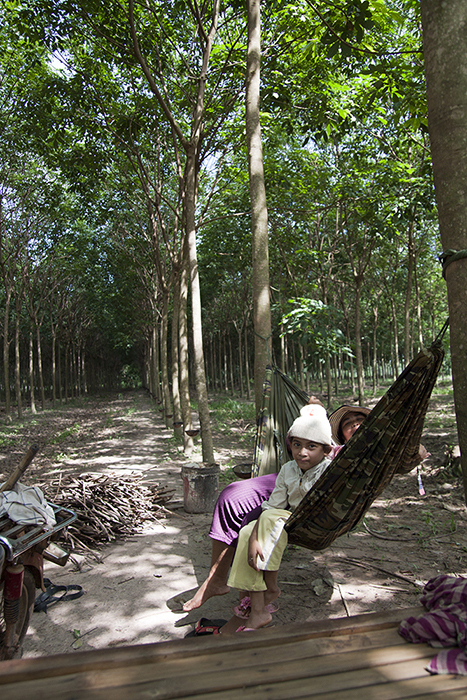 Photo 39: Rubber plantations and economic development, Cambodia, 2012. In order to foster economic development and maintain electoral votes, the Cambodian government has promised each family 0.05 km2 land. This means that the forest is cleared completely to make way for rubber plantations and agriculture. The Government plans to convert 28 % of the country’s forests into rubber plantations within the next 5 years.
Photo 39: Rubber plantations and economic development, Cambodia, 2012. In order to foster economic development and maintain electoral votes, the Cambodian government has promised each family 0.05 km2 land. This means that the forest is cleared completely to make way for rubber plantations and agriculture. The Government plans to convert 28 % of the country’s forests into rubber plantations within the next 5 years.
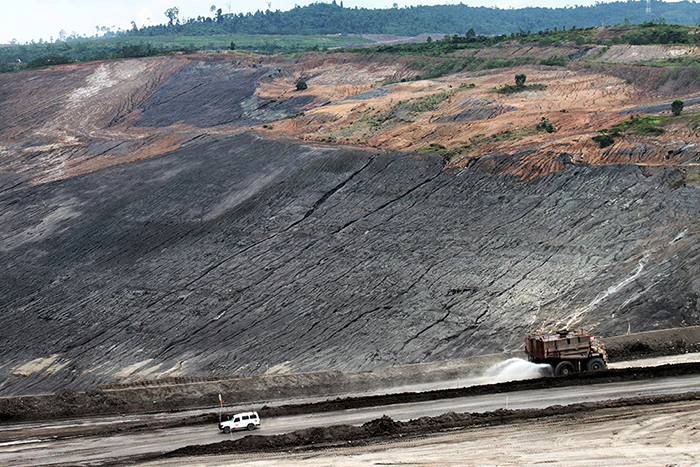 Photo 40: Coal mine, Borneo, Indonesia, 2009. When the coal is situated just below the surface of the ground, the forest and soil is peeled off to extract the coal. This coal mine attempts to become a local tourist attraction by inviting people to attend the company’s daily explosions.
Photo 40: Coal mine, Borneo, Indonesia, 2009. When the coal is situated just below the surface of the ground, the forest and soil is peeled off to extract the coal. This coal mine attempts to become a local tourist attraction by inviting people to attend the company’s daily explosions.
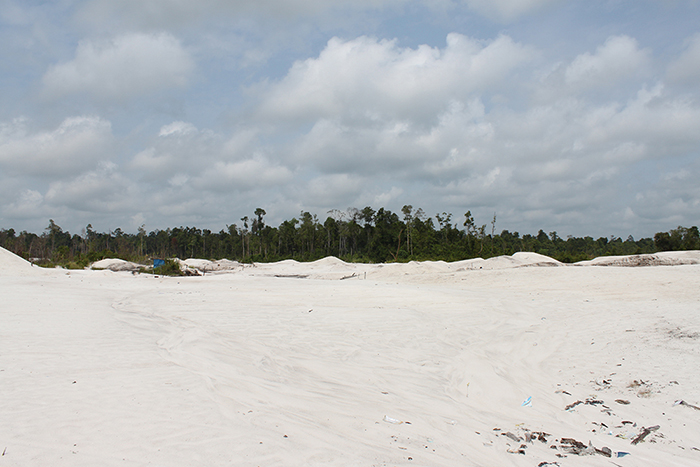 Photo 41: Gold mine, Borneo, Indonesia, 2009. This gold mine is located just outside Tanjung Puting National Park. The forest is converted into desert, and the people live in gold slums without health clinics and schools. Did you ask for sustainable gold, the last time you bought a piece of gold jewelry?
Photo 41: Gold mine, Borneo, Indonesia, 2009. This gold mine is located just outside Tanjung Puting National Park. The forest is converted into desert, and the people live in gold slums without health clinics and schools. Did you ask for sustainable gold, the last time you bought a piece of gold jewelry?
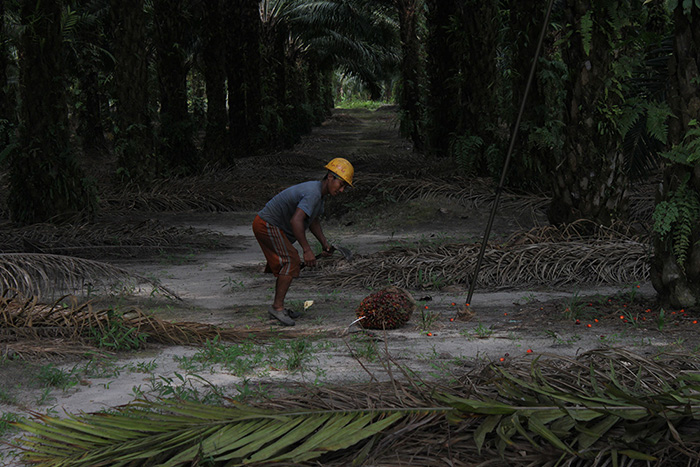 Photo 42: Worker in a oil palm plantation, Borneo, Indonesia, 2009. The picture shows oil palms in their most productive age (13 years). A large proportion of the palm oil is exported to Europe. One study found that if you buy 10 random products in a supermarket, there will be palm oil in 7 of them. The palm oil production is one of the main reasons for forests disappearing in Indoensia and Malaysia. In Indonesia the total area of oil palm increased with 279 % from 1998 to 2008.
Photo 42: Worker in a oil palm plantation, Borneo, Indonesia, 2009. The picture shows oil palms in their most productive age (13 years). A large proportion of the palm oil is exported to Europe. One study found that if you buy 10 random products in a supermarket, there will be palm oil in 7 of them. The palm oil production is one of the main reasons for forests disappearing in Indoensia and Malaysia. In Indonesia the total area of oil palm increased with 279 % from 1998 to 2008.
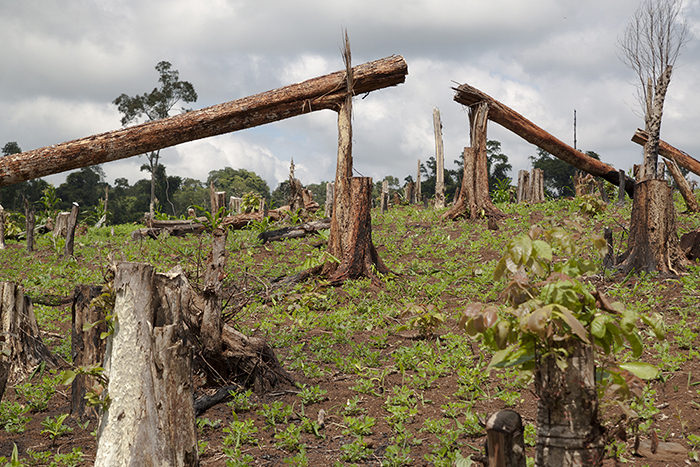 Photo 43: Indigenous people in Mondulkiri are clearing the forest to farm peanuts, Cambodia 2012. The indigenous people of the forest have the rights to clear the land for farming, but are not allowed sell the timber. Here, the valuable timber is therefore just burned.
Photo 43: Indigenous people in Mondulkiri are clearing the forest to farm peanuts, Cambodia 2012. The indigenous people of the forest have the rights to clear the land for farming, but are not allowed sell the timber. Here, the valuable timber is therefore just burned.
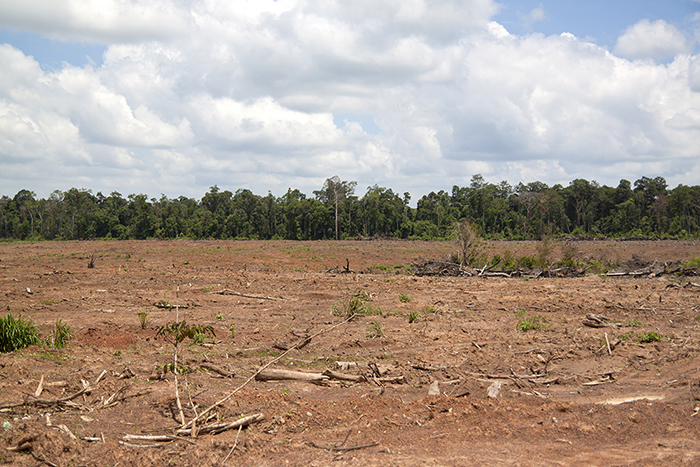 Photo 44: The forest is disappearing and turned into agricultural land, Cambodia, 2011. Increasing demand for agricultural land increases the pressure on forests.
Photo 44: The forest is disappearing and turned into agricultural land, Cambodia, 2011. Increasing demand for agricultural land increases the pressure on forests.
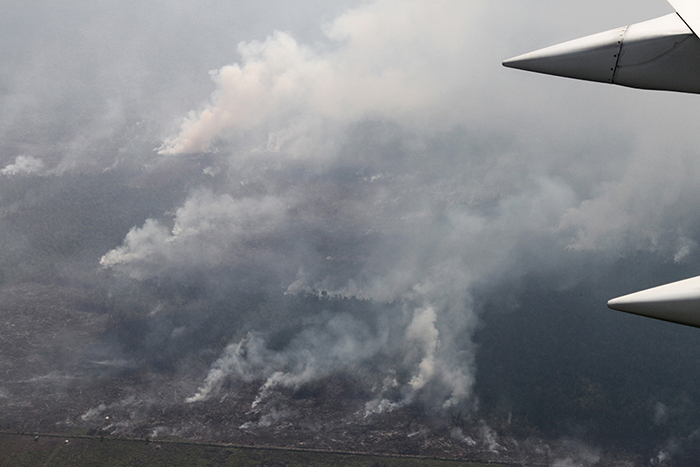 Photo 45: “Slash and burn farming,” Borneo, Indonesien, 2009. “Slash and burn farming,” where a forest area is first felled then burned, is a widespread method to clear forest land for agricultural purposes in the tropics. This contributes to forest fires. It is the cheapest way to clear land, and also adds nutrients to the otherwise poor soil from the burned plant material. However, the harmful smoke and the impact on climate are extensive. This method was also used in Denmark back in the old days.
Photo 45: “Slash and burn farming,” Borneo, Indonesien, 2009. “Slash and burn farming,” where a forest area is first felled then burned, is a widespread method to clear forest land for agricultural purposes in the tropics. This contributes to forest fires. It is the cheapest way to clear land, and also adds nutrients to the otherwise poor soil from the burned plant material. However, the harmful smoke and the impact on climate are extensive. This method was also used in Denmark back in the old days.
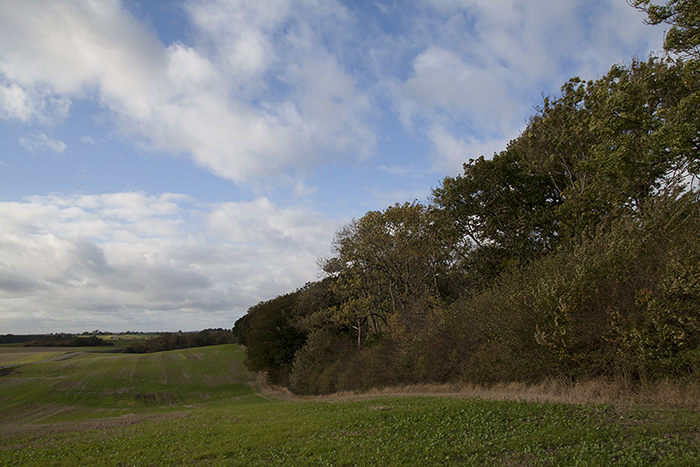 Photo 46: The border between forest and agriculture, Boserup, Denmark, 2012. About 200 years ago, Denmark had only 2 % forest cover. Today it is around 13 %. The Danish National Forest Programme has set a target of 20-25 % forest cover in 2100. Denmark’s forest cover is increasing. It increases by approx. 3000 hectare per year. In addition, the tree volume per area in the Danish forests also increases because the trees get bigger.
Photo 46: The border between forest and agriculture, Boserup, Denmark, 2012. About 200 years ago, Denmark had only 2 % forest cover. Today it is around 13 %. The Danish National Forest Programme has set a target of 20-25 % forest cover in 2100. Denmark’s forest cover is increasing. It increases by approx. 3000 hectare per year. In addition, the tree volume per area in the Danish forests also increases because the trees get bigger.
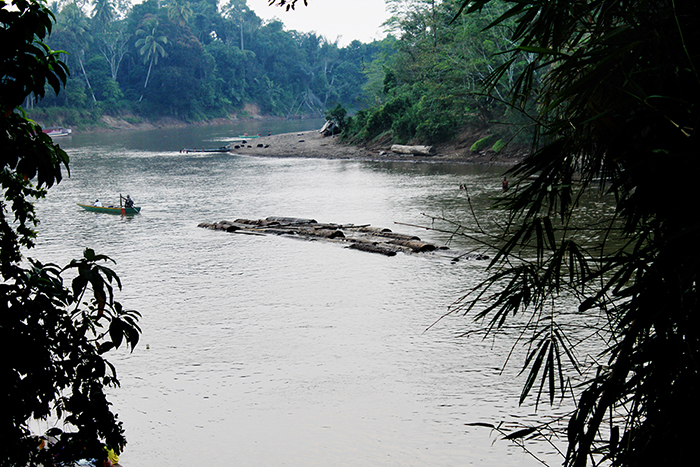 Photo 47: Local forest log (illegally) Borneo, Indonesien, 2009. When big companies buy forest land, locals can no longer use the forest as they have done for generations. Their felling of trees for their own use, such as building of house and boat, becomes illegal.
Photo 47: Local forest log (illegally) Borneo, Indonesien, 2009. When big companies buy forest land, locals can no longer use the forest as they have done for generations. Their felling of trees for their own use, such as building of house and boat, becomes illegal.
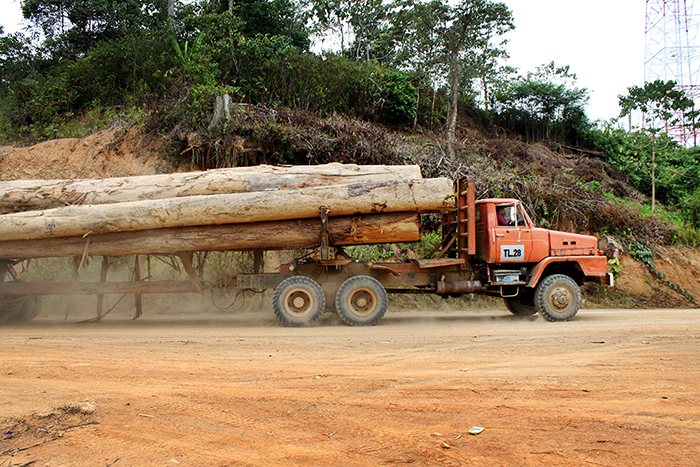 Photo 48: Legal forest logging in company-owned forest, Borneo, Indonesia, 2009.
Photo 48: Legal forest logging in company-owned forest, Borneo, Indonesia, 2009.
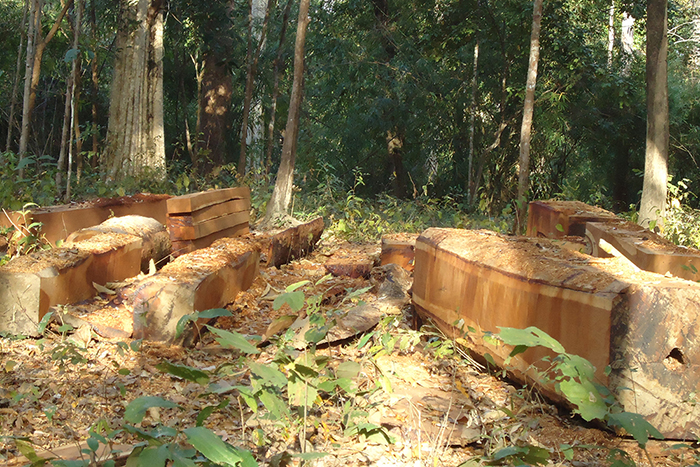 Photo 49: Confiscated illegal timber, Cambodia. Illegal timber is confiscated daily in countries such as Cambodia. The illegal logging is often carried out as organized crime, in which many different groups of people are involved. Local people earn money identifying and locating the finest and most valuable trees for felling, others cut down the trees, transport the timber out of the forest and others sell it on the market. The locals in Cambodia earn nearly DKK 100 for their work. The value of the most lucrative species is around DKK 18,000 per m3, when sold in neighboring Vietnam. Photographer: Rohit Singh, WWF Cambodia.
Photo 49: Confiscated illegal timber, Cambodia. Illegal timber is confiscated daily in countries such as Cambodia. The illegal logging is often carried out as organized crime, in which many different groups of people are involved. Local people earn money identifying and locating the finest and most valuable trees for felling, others cut down the trees, transport the timber out of the forest and others sell it on the market. The locals in Cambodia earn nearly DKK 100 for their work. The value of the most lucrative species is around DKK 18,000 per m3, when sold in neighboring Vietnam. Photographer: Rohit Singh, WWF Cambodia.
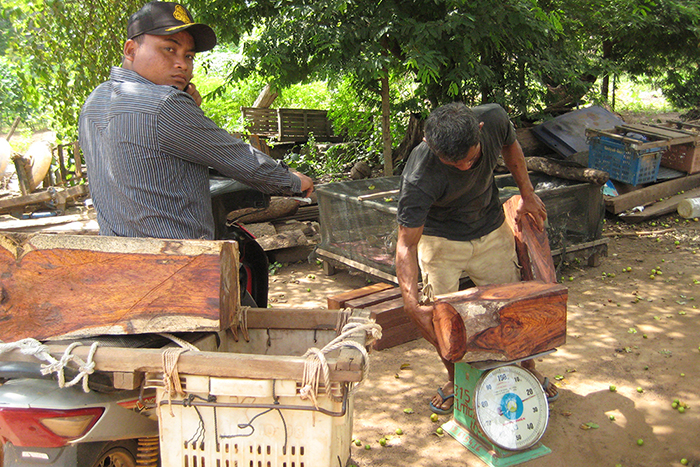 Photo 50: Illegal logged rosewood is being weighed, while the buyer is waiting, Cambodia. Sale and logging of rosewood Dalbergia cochinchinensis, and other luxury tree species, is illegal in Cambodia. Yet thousands of cubic meters of rosewood are exported each year from Cambodia to markets especially in China and Vietnam. Thus, rosewood makes up China’s largest import of wood from Cambodia. However, the majority of Cambodia’s rosewoods have already been felled. The trees that now remain are located in inaccessible areas such as high-altitude mountain regions. It is expected that by the end of 2014 all rosewood in the country will have been felled. In order to meet the demand and maintain the source of income, Cambodians instead log the trees illegally in Thailand. Photographer: Maya Pasgaard.
Photo 50: Illegal logged rosewood is being weighed, while the buyer is waiting, Cambodia. Sale and logging of rosewood Dalbergia cochinchinensis, and other luxury tree species, is illegal in Cambodia. Yet thousands of cubic meters of rosewood are exported each year from Cambodia to markets especially in China and Vietnam. Thus, rosewood makes up China’s largest import of wood from Cambodia. However, the majority of Cambodia’s rosewoods have already been felled. The trees that now remain are located in inaccessible areas such as high-altitude mountain regions. It is expected that by the end of 2014 all rosewood in the country will have been felled. In order to meet the demand and maintain the source of income, Cambodians instead log the trees illegally in Thailand. Photographer: Maya Pasgaard.
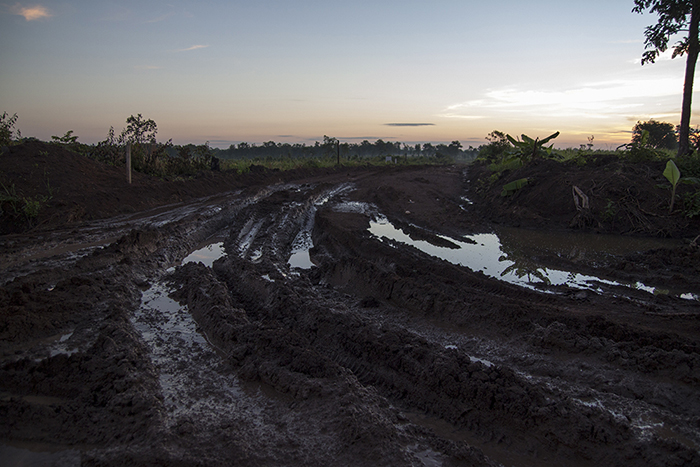 Photo 51: Truck traces from transportation of illegal timber from Mondulkiri National Park, Cambodia, 2012. Illegal logging and corruption (at the highest political level) go hand in hand in Cambodia. The police and the public authorities, who are to protect forests from being cut down illegally, are often the same people who make money by condoning it. A large part of the luxury tree species that are still left, grows in national parks. At night, the military close off roads leading to and from the national parks in order to protect them. But in many cases, the barrier only functions as a disguise, for illegal timber being transported out of the forest in the dead of the night. This is accomplished through bribing the military.
Photo 51: Truck traces from transportation of illegal timber from Mondulkiri National Park, Cambodia, 2012. Illegal logging and corruption (at the highest political level) go hand in hand in Cambodia. The police and the public authorities, who are to protect forests from being cut down illegally, are often the same people who make money by condoning it. A large part of the luxury tree species that are still left, grows in national parks. At night, the military close off roads leading to and from the national parks in order to protect them. But in many cases, the barrier only functions as a disguise, for illegal timber being transported out of the forest in the dead of the night. This is accomplished through bribing the military.
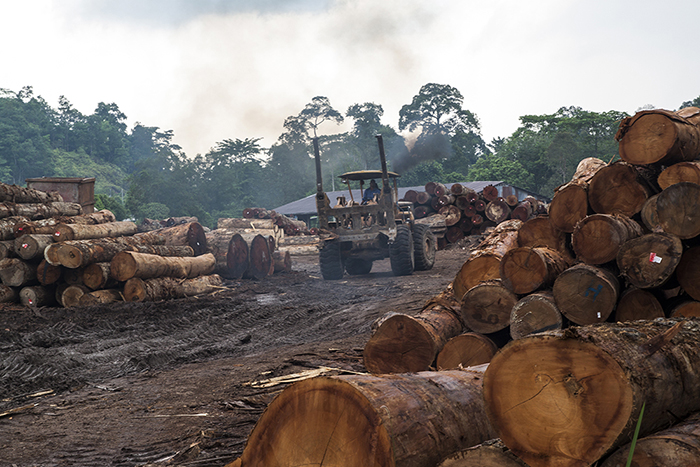 Photo 52: Sawmill, Malaysia Peninsular, 2012. The timber industry is one of Malaysia’s main sources of income – despite the fact that the country has largely exhausted its own forests. Several studies show that the timber industry instead has become one of the biggest buyers of illegal timber from neighboring Indonesia. Do you know where your wood products come from?
Photo 52: Sawmill, Malaysia Peninsular, 2012. The timber industry is one of Malaysia’s main sources of income – despite the fact that the country has largely exhausted its own forests. Several studies show that the timber industry instead has become one of the biggest buyers of illegal timber from neighboring Indonesia. Do you know where your wood products come from?
How can the forest be protected?
There is a growing awareness of the value of the forests and of why it is important to preserve them. This is indicated both by the celebration of the UN International Year of Forests in 2011 and by the inclusion of forests in the ongoing climate discussion. We can work with forest conservation on many different levels. In many countries, the first step is to make it clear who owns the land.
In the industrialized world, everyday choices play a major role in the protection of forests. How much paper do we use? How much of our paper is recycled? Do we keep track of where our paper and wood products came from? Do we remember to separate our waste?
What do you think can be done to protect the forests?
EDUCATION
Often, the lack of education and long-term planning lead to deforestation. Therefore, schools and other information activities are usually included in the work for the conservation of forests. Also in Europe, we need more education about the protection of forests here and about global connections that play a role in deforrestation in developing countries.
LAND RIGHTS
A good starting point for work on forest conservation is to clarify who owns the land or the forest. Secondly, it is important to create awareness that if you own land, you have a permanent value, as opposed to monetary values, which are more unstable. Having a piece of land means being able to produce food.
In Europe, it is clear who owns the land, but in many developing countries, things are not so simple.
NATIONAL PARKS AND OTHER PROTECTED AREAS
IUCN (International Union for Conservation of Nature) has introduced various land defintions, such as the concept of “national parks.” Often the national definitions are not following international ones. IUCN has six different categories of protected areas. These categories cover nature reserves with areas to which the public is refused admittance as well as areas with roads and houses. “Conservation area with a specific management plan” (Fredning in Danish) is a unique tool in the effort to protect nature in Denmark. The Danish Society for Nature Conservation is the only private organization, nationally and internationally, that is entitled to raise conservation trials. In 2011, the Society designated 15 areas to be conservation areas Denmark has 3500 procteted areas, many of which are forests.
What did you experience the last time you were in a national park?
THE VALUE OF NON TIMBER FOREST PRODUCTS
The direct and rapid economic gains invoved in cutting down forests are seductive. Other ways to make money in the forest are often less direct and their value may be difficult to asses.
How much are those mushrooms worth that you picked yesterday? What is the price of a cosy picnic? What is the value of the medicine plants which the locals have used for generations?
How much would you pay for a walk in the forest?
FOREST RESTORESTATION
Planting can be done in many different ways. But the easiest way is to see what the forests do themself, and try to learn as much as possible from that.
You can collect seeds or small trees from nearby forests and plant them where you want your forest. In the tropics, the big trees only produce seeds at long intervals, and when it happens, you need to make a move immediately.
How many trees have you planted?
CERTIFICATION SCHEMES
One way of pushing forest management in a more sustainable direction is to carry out certifications. A certification entails various requirements for the operation in question. There are many different certification schemes. The Danish State Forests are certified with both FSC (Forest Stewardship Council) and PEFC (Programme for the Endorsement of Forest Certification). More often, FSC is seen as the most sustainable certification scheme, for unlike PEFC, the FSC certification involves social issues such as indigenous peoples’ rights to use the forest. It is also the Certification that most Danish green organizations recommend.
Almost half of the Danish forests are FSC-certified. State forests were certified in 2007 and cover an area of about 110,000 hectares. This means that they are operated in accordance with national standards that meet FSC’s international principles for sustainable management. It first becomes specified at the national level. One of the criteria in the Standard for FSC Certification in Denmark is for example: “Minimum 3-5 trees per hectare is ongoing being left for natural decay and death. These trees should preferably be mature, native and of different species.”
Do you buy FSC certified paper and wood products?
REDD REDUCING EMISSIONS FROM DEFORESTATION AND FOREST DEGRADATION
On the international stage, work is undertaken to deal with CO2 credits or equivalents. The tropical forests have long been included in this effort. Around 17% of the man-made greenhouse gas emissions come from the loss of tropical forest. Briefly told REDD should be giving industrialized countries the possibility to buy the CO2 which is bound in the tropical forests. In this way developing countries get a monetary incentive to leave their forests standing. A good idea, but it is very difficult to translate this into reality, because there is a very long distance between the European stock exchanges and the indigenous peoples in the forests.
What do you do to reduce CO2 emissions?
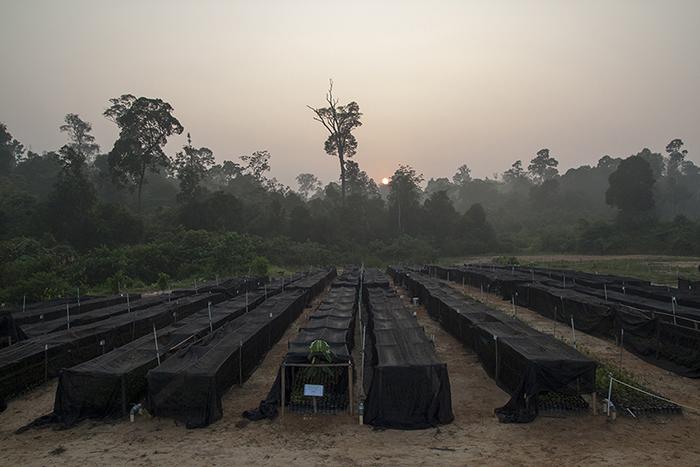 Photo 53: Tree nursery in the Harapan Rainforest project, Sumatra, Indonesien, 2012. Harapan Rainforest is reportedly the world’s largest reforestation project. The area, which covers some 100.000 hectare, used to be a production forest, and this has seriously affected the quality of the forest. With support from e.g. Danida in Denmark, money has now been given to regenerate the forest. This requires the planting of thousands of trees, and a number of nurseries have therefore been established. At this nursery alone, approx. 900,000 small trees are grown. Hopefully one day they will become forest. Harapan is Indonesian and means exactly “hope.”
Photo 53: Tree nursery in the Harapan Rainforest project, Sumatra, Indonesien, 2012. Harapan Rainforest is reportedly the world’s largest reforestation project. The area, which covers some 100.000 hectare, used to be a production forest, and this has seriously affected the quality of the forest. With support from e.g. Danida in Denmark, money has now been given to regenerate the forest. This requires the planting of thousands of trees, and a number of nurseries have therefore been established. At this nursery alone, approx. 900,000 small trees are grown. Hopefully one day they will become forest. Harapan is Indonesian and means exactly “hope.”
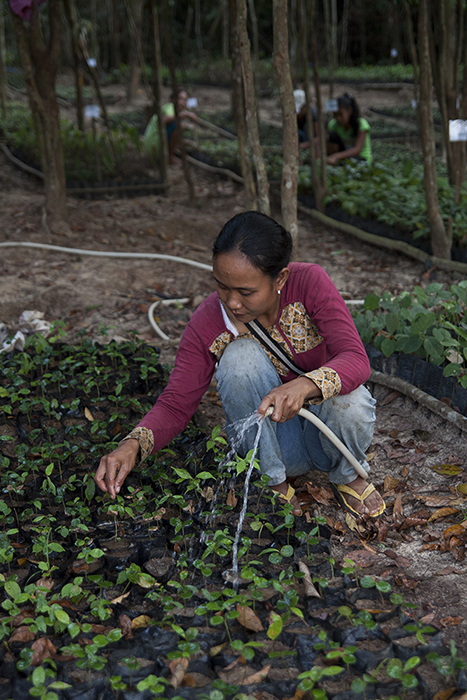 Photo 54: Community tree nursery in the Harapan Rainforest Project, Sumatra, Indonesien, 2012. Besides the Harapan Rainforest Project´s own nurseries, the project has also established a number of village-run nurseries. The locals gather seeds and plant trees, which will be replanted in the forest later on. This provides the locals with an income, so that they are not dependent on cutting down the forest for agricultural purposes. This nursery has approx. 70,000 small trees. Have you ever planted trees?
Photo 54: Community tree nursery in the Harapan Rainforest Project, Sumatra, Indonesien, 2012. Besides the Harapan Rainforest Project´s own nurseries, the project has also established a number of village-run nurseries. The locals gather seeds and plant trees, which will be replanted in the forest later on. This provides the locals with an income, so that they are not dependent on cutting down the forest for agricultural purposes. This nursery has approx. 70,000 small trees. Have you ever planted trees?
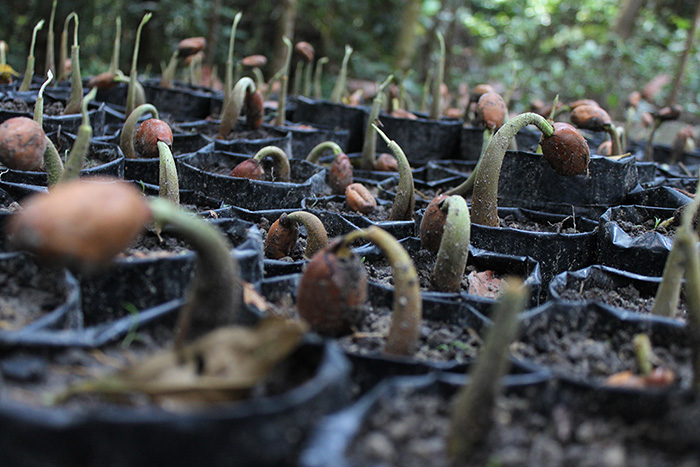 Photo 55: Wild Durian, Borneo, Indonesien, 2009. Wild durian Durio ocleanus grows in Pesalat Reforestation Project in Tanjung Puting National Park. These shoots are approx. one month old. Tree planting is needed in the national park, as about 75 % of the forest here is in poor condition. It is typical for natural forest restoration to make use of fruit trees. Fruits attract animals, and they spread the seeds through their faeces. This way the forest restoration happens faster.
Photo 55: Wild Durian, Borneo, Indonesien, 2009. Wild durian Durio ocleanus grows in Pesalat Reforestation Project in Tanjung Puting National Park. These shoots are approx. one month old. Tree planting is needed in the national park, as about 75 % of the forest here is in poor condition. It is typical for natural forest restoration to make use of fruit trees. Fruits attract animals, and they spread the seeds through their faeces. This way the forest restoration happens faster.
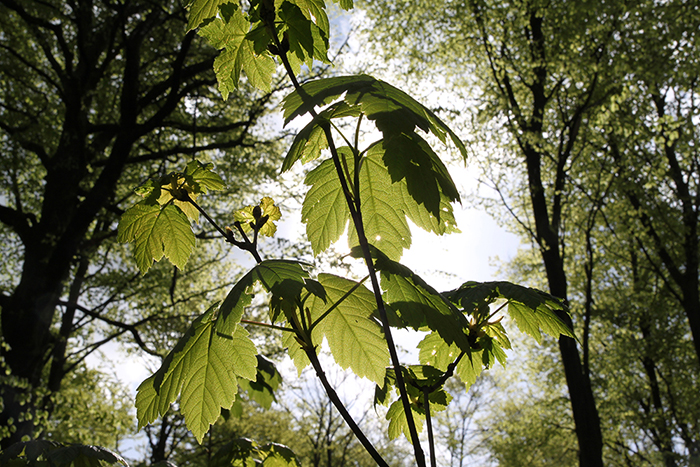 Photo 56: The sycamore maple, Acer pseudoplatanus, Jonstrup Vang, Danmark, 2012
Photo 56: The sycamore maple, Acer pseudoplatanus, Jonstrup Vang, Danmark, 2012
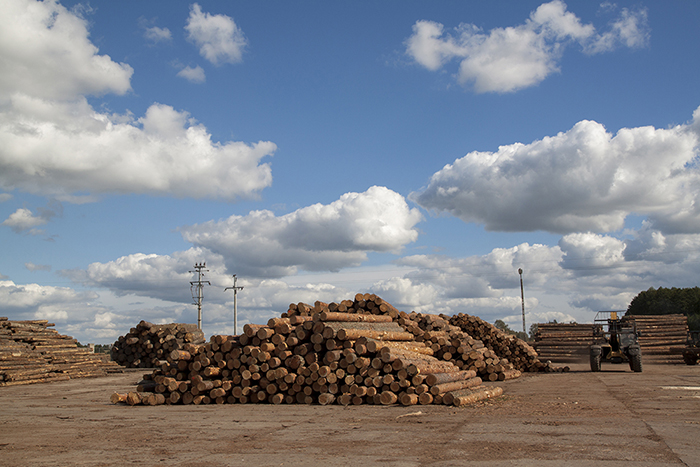 Photo 57: FSC-certified timber, Konar Sawmill, Poland, 2012. In order for wood products to be given the FSC label, it is necessary to be able to demonstrate that the wood comes from a sustainably managed forest. Therefore, the products must be traceable through all stages of the value chain – from the forest to the sawmill, through the production stage and all the way to the final product we find at the dealers’. FSC has therefore developed a traceability system – Chain of Custody- by which all links in the chain must be certified. Konar sawmill in Poland was FSC certified in 2005 and has since bought all their timber from sustainably managed state forests in Poland. When the wood is cut up and processed, it is exported mainly to western countries. In Poland, demand for FSC is very small.
Photo 57: FSC-certified timber, Konar Sawmill, Poland, 2012. In order for wood products to be given the FSC label, it is necessary to be able to demonstrate that the wood comes from a sustainably managed forest. Therefore, the products must be traceable through all stages of the value chain – from the forest to the sawmill, through the production stage and all the way to the final product we find at the dealers’. FSC has therefore developed a traceability system – Chain of Custody- by which all links in the chain must be certified. Konar sawmill in Poland was FSC certified in 2005 and has since bought all their timber from sustainably managed state forests in Poland. When the wood is cut up and processed, it is exported mainly to western countries. In Poland, demand for FSC is very small.
Photo 58: Danish Timber ready to be exported to Vietnam, Hvalsø Savmill, Sealand, Denmark, 2012. Hvalsø Sawmill became chain of custody certified under FSC in 2008 and was the first hardwood sawmill in Denmark to offer FSC-certified hardwood. The sawmill also has a FSC Controlled Wood certificate. Such certification does not have to meet the same requirements for sustainability as FSC certified wood, but among other things it ensures that the wood is harvested legally and that human rights are respected in the timber production. Controlled Wood are used in conjunction with FSC-certified wood and sold under the name FSC Mixed Sources.
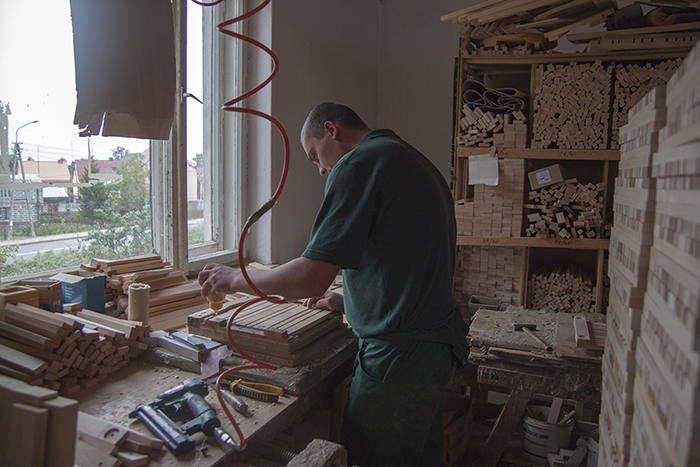 Photo 59: Woodproducts from FSC certified forests Kon-Stol, Poland, 2012 .The family-owned business Kon-Stol manufactures furniture and timber products. The majority of their exports go to Germany, and due to demand from customers, they converted the factory to FSC-production in 2010. Today, all their timber comes from FSC certified forests. When choosing FSC-labeled products – from furniture and flooring to paper and packaging – you help to ensure sustainable management of forests. Do you think of FSC, when you buy wood- and paper products?
Photo 59: Woodproducts from FSC certified forests Kon-Stol, Poland, 2012 .The family-owned business Kon-Stol manufactures furniture and timber products. The majority of their exports go to Germany, and due to demand from customers, they converted the factory to FSC-production in 2010. Today, all their timber comes from FSC certified forests. When choosing FSC-labeled products – from furniture and flooring to paper and packaging – you help to ensure sustainable management of forests. Do you think of FSC, when you buy wood- and paper products?
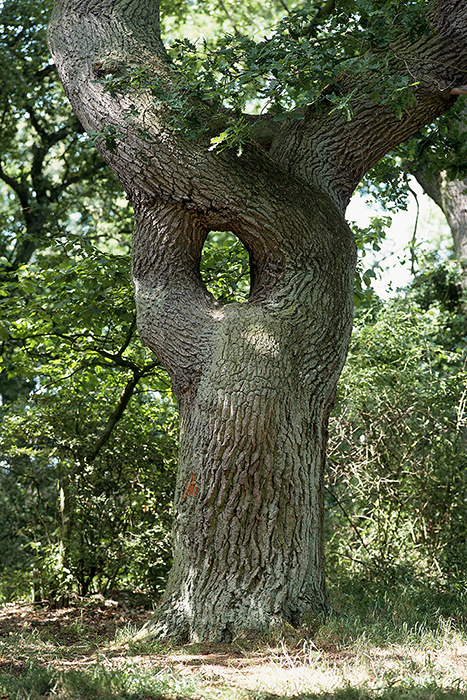 Photo 60: The funny old oak, Jutland, Denmark. The tree is 200-300 years old and grows in Langå Egeskov by the lakefront of the Gudenå. It can live on for hundreds of years, as a real Eternity tree. Here are a myriad of birds that find good holes in the old and dead trees to build nests in. Lots of rare insects and fungi also thrive on the old and dead trees. Acorns are collected from the trees for planting elsewhere, because the oak trees at Langå are considered to be especially fine Danish landscape oak. The forest is owned by the Danish Fund for Nature. Text and photo by the Danish Society for Nature Conservation. Photographer: Bert Wiklund / bwfoto.dk.
Photo 60: The funny old oak, Jutland, Denmark. The tree is 200-300 years old and grows in Langå Egeskov by the lakefront of the Gudenå. It can live on for hundreds of years, as a real Eternity tree. Here are a myriad of birds that find good holes in the old and dead trees to build nests in. Lots of rare insects and fungi also thrive on the old and dead trees. Acorns are collected from the trees for planting elsewhere, because the oak trees at Langå are considered to be especially fine Danish landscape oak. The forest is owned by the Danish Fund for Nature. Text and photo by the Danish Society for Nature Conservation. Photographer: Bert Wiklund / bwfoto.dk.
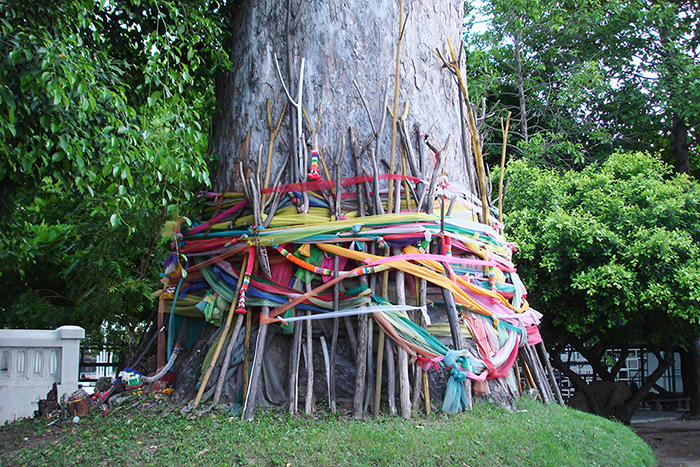 Photo 61: Sacred tree next to the temple Chedi Luang, Chiang Mai, Thailand, 2007. For many people, large trees are associated with great spirits. In Thailand you show respect and appreciation for wood spirits and angels by tying colored ribbons around the trees. A tree with such a colored ribbon is usually protected from felling. Often environmental organisations therefore use this technique to protect trees.
Photo 61: Sacred tree next to the temple Chedi Luang, Chiang Mai, Thailand, 2007. For many people, large trees are associated with great spirits. In Thailand you show respect and appreciation for wood spirits and angels by tying colored ribbons around the trees. A tree with such a colored ribbon is usually protected from felling. Often environmental organisations therefore use this technique to protect trees.
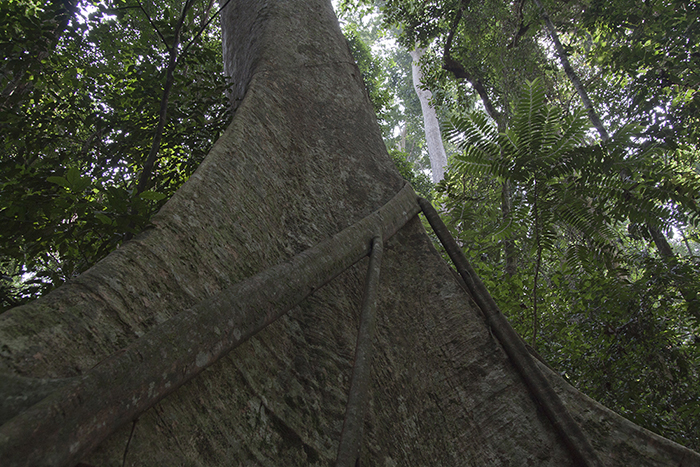 Photo 62: Disc-shaped tree, Taman Negara, Malaysia, 2012. Taman Negara is reportedly the world’s oldest forest and in 1939 it was protected as Malaysia’s first national park. The National Park covers an area of 4343 km2, equivalent to 7 times the area of Bornholm. The conservation has protected a unique biodiversity and amongst other things, the forest is home to tigers.
Photo 62: Disc-shaped tree, Taman Negara, Malaysia, 2012. Taman Negara is reportedly the world’s oldest forest and in 1939 it was protected as Malaysia’s first national park. The National Park covers an area of 4343 km2, equivalent to 7 times the area of Bornholm. The conservation has protected a unique biodiversity and amongst other things, the forest is home to tigers.
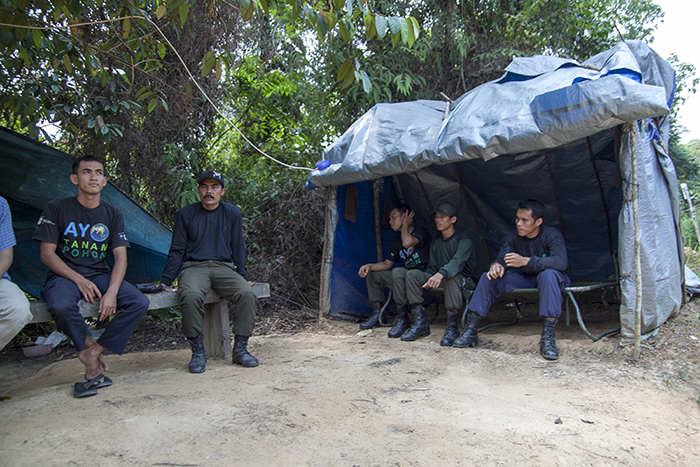 Photo 63: Forest patrolling in the Harapan Rainforest Project, Sumatra, Indonesia, 2012. Indonesia is one of the countries in the world where illegal logging is worst. In Harapan, 8 patrols of 6-8 guards daily patrol the forest to protect it against illegal logging, poaching and illegal immigrants who cut down forest to convert it into plantations or agriculture.
Photo 63: Forest patrolling in the Harapan Rainforest Project, Sumatra, Indonesia, 2012. Indonesia is one of the countries in the world where illegal logging is worst. In Harapan, 8 patrols of 6-8 guards daily patrol the forest to protect it against illegal logging, poaching and illegal immigrants who cut down forest to convert it into plantations or agriculture.
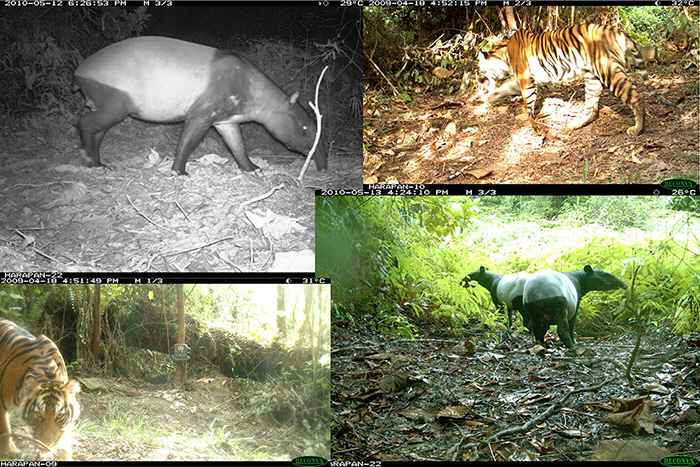 Photo 64: Camera trap from the Harapan Rainforest Project, Sumatra, Indonesien, 2012. This collage of animals are photographed by camera traps in Harapan Rainforest Project. Camera traps are set up to take pictures of the forest’s animals, to find out which species exist in the area. Harapan forest is home to about 20 tigers. There are many good reasons why tigers must be preserved. One reason is that the tiger is a so-called umbrella species: An umbrella species is a predator at the top of the food chain. Protecting the umbrella species means protecting the entire ecosystem.
Photo 64: Camera trap from the Harapan Rainforest Project, Sumatra, Indonesien, 2012. This collage of animals are photographed by camera traps in Harapan Rainforest Project. Camera traps are set up to take pictures of the forest’s animals, to find out which species exist in the area. Harapan forest is home to about 20 tigers. There are many good reasons why tigers must be preserved. One reason is that the tiger is a so-called umbrella species: An umbrella species is a predator at the top of the food chain. Protecting the umbrella species means protecting the entire ecosystem.
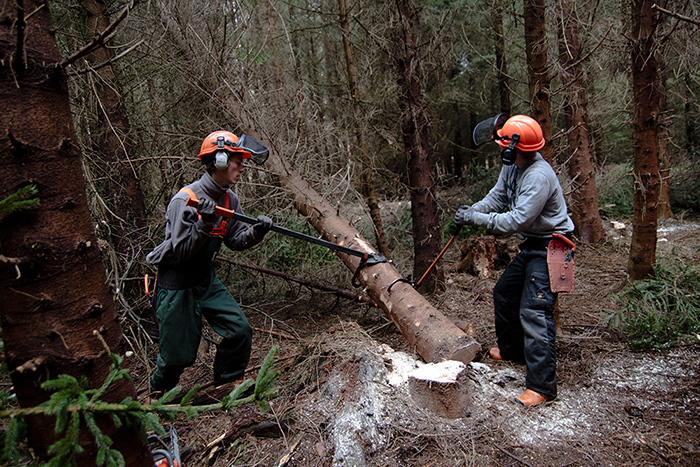 Photo 65: Forest worker students felling a European Spruce, Picea abies, Bidstrup skov, Danmark, 2012. This forest is as state forest both certified with FSC and PEFC. Despite modern machines, it is still very hard physical work to be a forest worker. Maybe that is the price for having a wonderful working place. Would you like to work in the forest?
Photo 65: Forest worker students felling a European Spruce, Picea abies, Bidstrup skov, Danmark, 2012. This forest is as state forest both certified with FSC and PEFC. Despite modern machines, it is still very hard physical work to be a forest worker. Maybe that is the price for having a wonderful working place. Would you like to work in the forest?
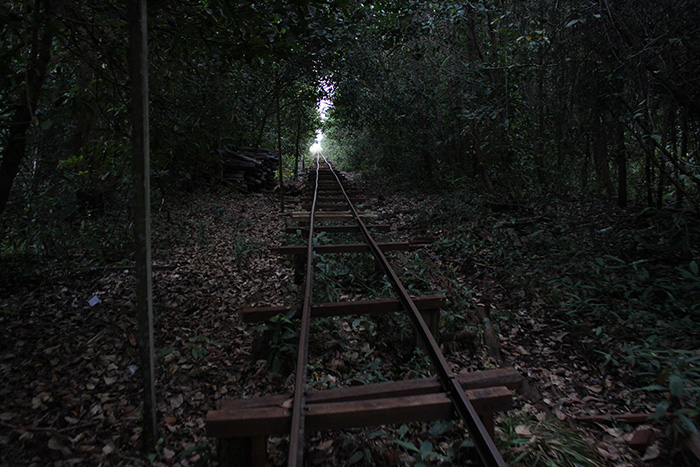 Photo 66: Timber train tracks, Borneo, Indonesien, 2009. Train tracks which previously led timber out of the forest. In 2005, the area gained status of national park and the railroad tracks now leads to an international research station. The area has an estimated population of 6900 orangutans.
Photo 66: Timber train tracks, Borneo, Indonesien, 2009. Train tracks which previously led timber out of the forest. In 2005, the area gained status of national park and the railroad tracks now leads to an international research station. The area has an estimated population of 6900 orangutans.
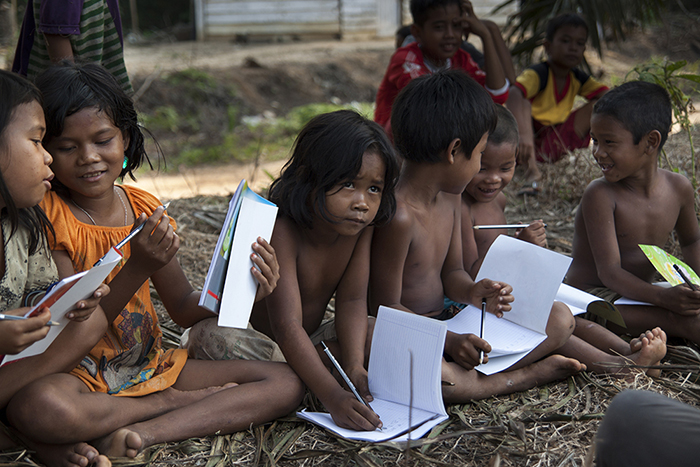 Photo 67: Tree species ABC, Harapan Rainforest Project, Sumatra, Indonesien, 2012. 7-800 indigenous people live in Harapan Forest. As part of the forest restoration project, the children are offered a school education. The lessons are based on the children’s knowledge of the forest. For instance, they are taught the alphabet through listing tree species they know with the initial letters a, b, c, etc.
Photo 67: Tree species ABC, Harapan Rainforest Project, Sumatra, Indonesien, 2012. 7-800 indigenous people live in Harapan Forest. As part of the forest restoration project, the children are offered a school education. The lessons are based on the children’s knowledge of the forest. For instance, they are taught the alphabet through listing tree species they know with the initial letters a, b, c, etc.
